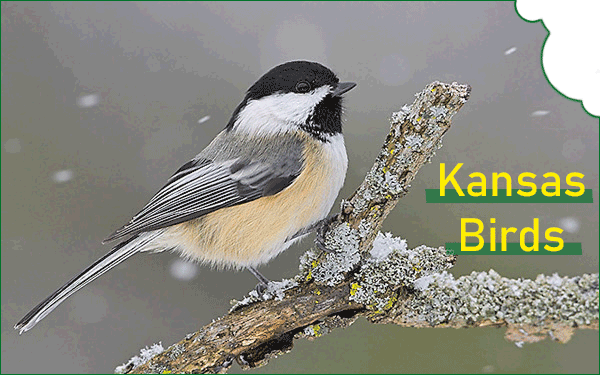
The birds of Kansas include the Greater Prairie-Chicken, the cheerful Dickcissel, migrant shorebirds, and more than 480 additional species.
Kansas provides habitat for hundreds of interesting birds! Grassland species live in prairies and farming fields, wading birds frequent wetlands, and wooded habitats host gorgeous Painted Buntings and other beautiful songbirds.
How many birds in Kansas have you seen?
We bet you’ve see a lot but how many were you able to identify?
This list of the most common backyard and wild birds in Kansas will help!
On this page
- Birds of Kansas
- 40. Red-headed Woodpecker
- 39. Great Crested Flycatcher
- 38. Eastern Kingbird
- 37. Eastern Phoebe
- 36. White-throated Sparrow
- 35. Song Sparrow
- 34. Baltimore Oriole
- 33. Eastern Meadowlark
- 32. Harris’s Sparrow
- 31. Eurasian Collared-Dove
- 30. Indigo Bunting
- 29. Ring-billed Gull
- 28. Brown-headed Cowbird
- 27. Barn Swallow
- 26. Eastern Bluebird
- 25. Common Grackle
- 24. Killdeer
- 23. Mallard
- 22. White-breasted Nuthatch
- 21. Great Blue Heron
- 20. Turkey Vulture
- 19. Red-Tailed Hawk
- 18. Northern Flicker
- 17. Carolina Wren
- 16. Red-winged Blackbird
- 15. Dark-eyed Junco
- 14. House Sparrow
- 13. Tufted Titmouse
- 12. Canada Goose
- 11. European Starling
- 10. American Goldfinch
- 9. House Finch
- 8. Downy Woodpecker
- 7. Red-bellied Woodpecker
- 6. American Crow
- 5. Black-capped Chickadee
- 4. Mourning Dove
- 3. American Robin
- 2. Blue Jay
- 1. Northern Cardinal (Most Popular Kansas Bird)
- Frequently Asked Questions About Birds of Kansas
Birds of Kansas
In Kansas, birds are present in open, wooded, and wetland habitats all across the state. But which are the most common species?
To make an accurate list of common birds of Kansas, we researched eBird data from 2021 to 2023. We found the most commonly seen species and arranged them from most common to least common.
To help identify these common birds of Kansas, we included information about their behavior and field marks.
From 40 to 1.
40. Red-headed Woodpecker
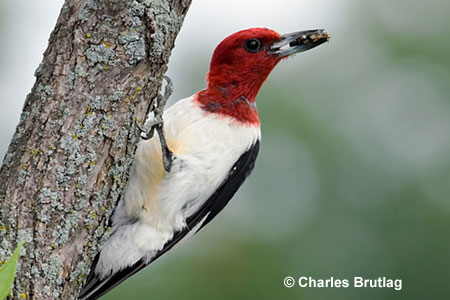
Scientific name: Melanerpes erythrocephalus
Length: 9.25 inches
Weight: 2.5 ounces
Wingspan: 17 inches
Song: “kwueeh”
The Red-headed Woodpecker is a medium-sized, boldly patterned woodpecker with a velvet red head. It has a black back with glossy blue highlights, white rump, and a pointed, black tail.
Both sexes are similar and have snow white underparts, a big white patch in their wings, and a fairly long, pointed, grayish beak.
In flight, the white on their wings, rump, and underparts are obvious field marks. They have an undulating flight pattern that looks as if the bird is bounding up and down in the air.
Young birds look like adults but have grayish-brown heads.
Red-headed Woodpeckers eat seeds, nuts, fruit, insects, and other small creatures. They fly into the air to catch insects in flight, and pick other food items from bark and foliage.
This species nests in tree cavities and lives in a variety of semi-wooded and woodland habitats. We find Red-headed Woodpeckers in parts of southern Canada and the eastern USA west to the plains of Montana.
Key Identifications:
- Medium-sized black and white woodpecker with a deep red head.
- Sallies into the air to catch insects and forages on trees.
- Nests in a tree cavity.
- Makes a loud, brief and raspy, “kwueeh“.
The Red-headed Woodpecker is a black and white woodpecker with a red head. It lives in semi-open and wooded habitats, especially areas with oak trees. This species is the only woodpecker in North America that stores insects and other food items and covers them with a piece of wood or bark.
39. Great Crested Flycatcher
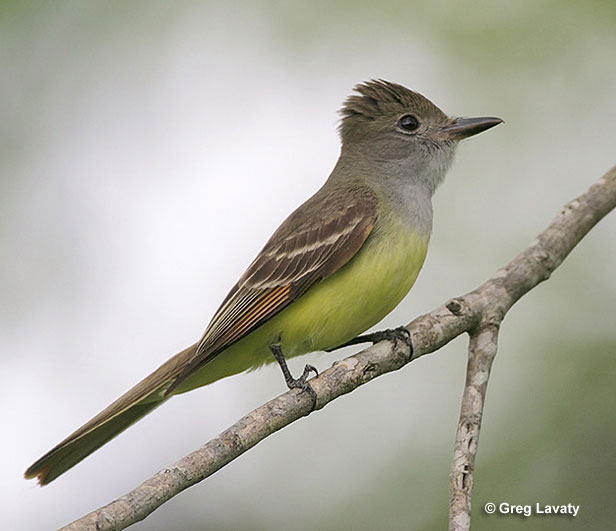
Scientific name: Myiarchus crinitus
Length: 8.75 inches
Weight: 1.2 ounces
Wingspan: 13 inches
Song: “Wheep!”
The Great-crested Flycatcher is a medium-sized flycatcher species with a big, crested head, and a large beak.
Both sexes look the same and are olive-brown above, have gray on their face, throat, and breast, and yellow on their lower breast and belly.
They also have two white wings bars, white edging on some of the other feathers in their wings, and a reddish-brown tail.
Great-crested Flycatchers eat insects and some small fruits. They forage by flying and catching prey in the air, from foliage, or even on the ground.
This flycatcher species nests inside crevices and cavities in trees. It builds its soft, shallow cup nest out of moss, grass, and other bits of vegetation.
The Great-crested Flycatcher breeds in wooded habitats in parts of central and southern Canada, and in much of the eastern USA. It migrates to tropical habitats in southern Florida, the Caribbean, and southern Mexico to Venezuela.
Key Identifications:
- Medium-sized, crested flycatcher with two wing bars, gray on the face and chest, yellow belly, and a rufous tail.
- Flies from a perch to catch insects in the air, from foliage, and on the ground.
- Makes a soft cup nest of moss and grass inside a tree cavity.
- Often makes a short but loud and rising “Wheep!“. It also makes short “reedy” calls and brief “reep” vocalizations.
The Great-crested Flycatcher is a fair-sized, crested, pale brown and gray bird with two pale wing bars and a reddish-brown tail. It breeds in a variety of wooded habitats and winters in tropical forests. This species often uses shed snakeskin as nesting material and may use it to repel nest predators.
38. Eastern Kingbird
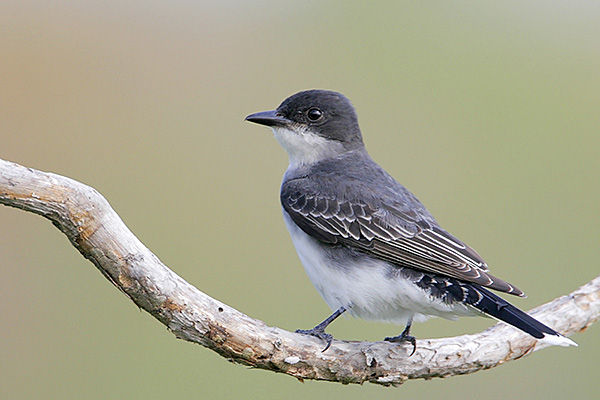
Scientific name: Tyrannus tyrannus
Length: 8.5 inches
Weight: 1.4 ounces
Wingspan: 15 inches
Song: “sipea sitpipee”
The Eastern Kingbird is a medium-sized flycatcher that is blackish above and white below. Males and females look the same and also have a bold, white tip on their longish, rectangular tail.
With a close look, we can see that their back is dark gray and their head, wings, and tail are black. They also have white edging on the feathers of their long wings, and a gray wash on their chest.
Eastern Kingbirds eat insects and berries. They forage by flying into the air from a perch and catching the bug in flight. They also hover to pick berries from trees.
This flycatcher species builds a loose cup nest out of grass and twigs in a tree.
The Eastern Kingbird breeds in meadows and other open habitats in a large part of Canada, the eastern USA, and eastern Washington to Utah. They migrate to western Amazonia to northern Argentina.
Key Identifications:
- Medium-sized black and white flycatcher with a bold white tip on its tail.
- Forages in meadows and other open areas for insects.
- Builds a loose cup nest of twigs and grass in a tree.
- Makes high-pitched calls, “sipea sitpipee“.
The Eastern Kingbird is a bold, black and white flycatcher of open habitats. It is a summer resident in many parts of Canada and the eastern and northern USA, and winters in South America. During migration and winter, Eastern Kingbirds form large flocks that feed on fruiting trees.
37. Eastern Phoebe
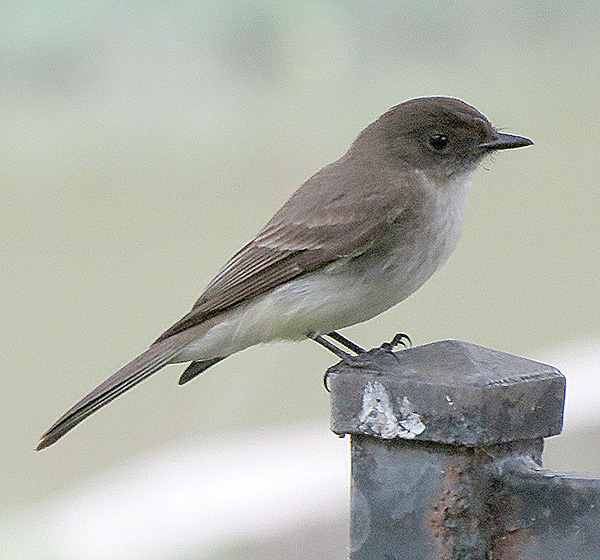
Photograph © Sam Crowe.
Scientific name: Sayornis phoebe
Length: 7 inches
Weight: .7 ounces
Wingspan: 10.5 inches
Song: “see-BEE! See BIDIT”
The Eastern Phoebe is a small to medium-sized, plain flycatcher that is dark, brownish gray above, and white below. It also has gray on its breast and a long, blackish tail constantly wagged up and down.
This bird also has a blackish head and some pale edging on long, dark wings. Males and females look alike but young birds have pale yellow bellies.
This flycatcher uses its slender beak to snap up insects. It catches them by flying from a perch and snatching them in flight, from foliage while hovering, and from the ground.
We usually see Eastern Phoebes on their own, sitting on low or medium-height perches. They make cup nests of mud, moss, and leaves on rocky outcrops, and under bridges and other structures.
This species breeds in woodlands and parks in Canada and the eastern USA, and winters in similar habitats the southeastern USA and Mexico.
Key Identifications:
- Plain, mid-sized flycatcher that is dark brownish-gray above and pale below with some gray on the breast.
- Perches low to mid-height in woodlands and flies out to catch insects. It also feeds on berries in winter.
- Makes a cup nest of mud and vegetation on structures and rocky outcrops.
- Sings a song that sounds like its name, “see-BEE! See BIDIT”.
The Eastern Phoebe is a featureless flycatcher with dark upperparts and pale underparts. It often wags its tail up and down and sallies from perches to catch insects. In 1804, this species became the first bird to be banded in North America when John James Audubon put silvered thread on an Eastern Phoebe’s leg.
36. White-throated Sparrow
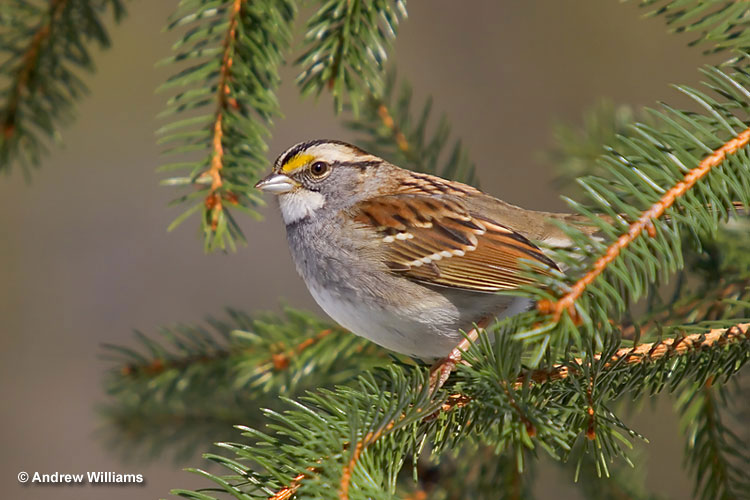
Scientific name: Zonotrichia albicollis
Length: 6.75 inches
Weight: .91 ounces
Wingspan: 9 inches
Song: “Ohhh Canada Canada Canada”
The White-throated Sparrow is a chunky, gray and brown sparrow with a white throat, and black and white stripes on its head. It has dark streaks on its back, a gray rump, and a bit of yellow in front of its eyes.
Males and females look the same and have reddish-brown wings with two white wing bars. Young White-throated Sparrows and some adults are duller brown with tan stripes on their heads and a dingy white throat.
White-throated Sparrows forage for seeds and insects on the ground, and also eat fruits in short trees and bushes. They reveal hidden food items by using their feet to scratch and kick away leaves.
This sparrow breeds in northern forests and builds a cup nest with grass and twigs.
These sparrows usually occur in flocks and winter in the eastern and southwestern USA and parts of California.
Key Identifications:
- Large sparrow with a white throat and bold black and white or tan stripes on its head.
- Scratches leaves on the ground to find seeds and insects. They also eat berries.
- Makes a cup nest of grass, bark, and twigs, on the ground, under dense vegetation.
- Flocks of White-throated Sparrows often make sharp “tink” calls. They also sing a clear, whistled song, “Ohhh Canada Canada Canada” or, “Ohhh, Cana, Cana, Cana”.
White-throated Sparrows are hefty gray and brown sparrow species with white throats, and black and white or tan stripes on their head. They breed in northern forests and flock together during the winter in various woodland habitats. The yellow pigment in the patches in front of their eyes comes from eating colorful berries during fall and winter.
35. Song Sparrow
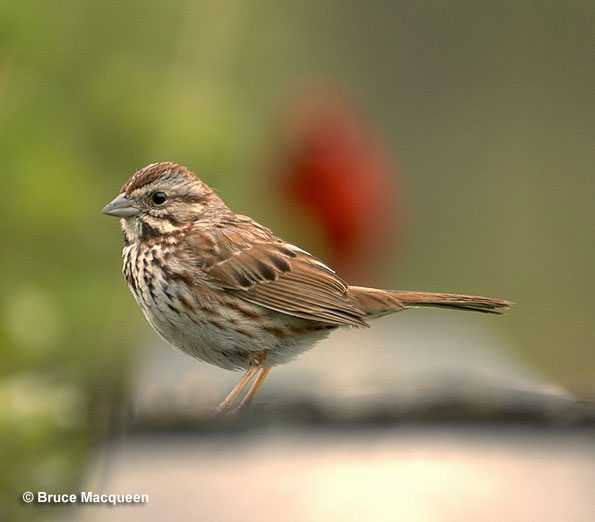
Scientific name: Melospiza melodia
Length: 6.25 inches
Weight: .7 ounces
Wingspan: 8.25 inches
Song: “seet serate sitsziziziziziziziz seet”
The Song Sparrow is a small, gray and brown, streaked songbird with a thick dark mark on each side of its white throat. Males and females look the same and have white underparts with a dark brown mark on their breast, and dark brown streaks on their breast and sides.
Most Song Sparrows also have two narrow wing bars and show a rounded tail when fluttering between bushes.
This species feeds on insects, seeds, and small fruits. Pairs forage by picking up food items on and near the ground. They are also frequent visitors to bird feeders, where they love millet.
Song Sparrows use grass, stems, hair, and other materials to make a cup nest placed on or near the ground. They nest in dense vegetation, shrubbery, or low trees, often near water.
This species uses a wide variety of brushy habitats in open and wooded situations in southern Alaska, most of Canada, and all of the USA.
Key Identifications:
- Small brown, streaked sparrow with a dark mark on its breast.
- Forages on and near the ground for seeds and insects in brushy habitats.
- Builds a cup nest on or near the ground in a shrub or low tree.
- Makes high-pitched “tink“, chirping calls, and has a cheerful song with a trill, “seet serate sitsziziziziziziziz seet“.
Song Sparrows are reddish-brown songbirds with dark brown streaks and a dark brown breast patch on white underparts. They usually occur in pairs and are often heard and seen in brushy areas and large gardens. There are several subspecies with distinct plumages including a large, dark one that lives on the Aleutian Islands.
34. Baltimore Oriole
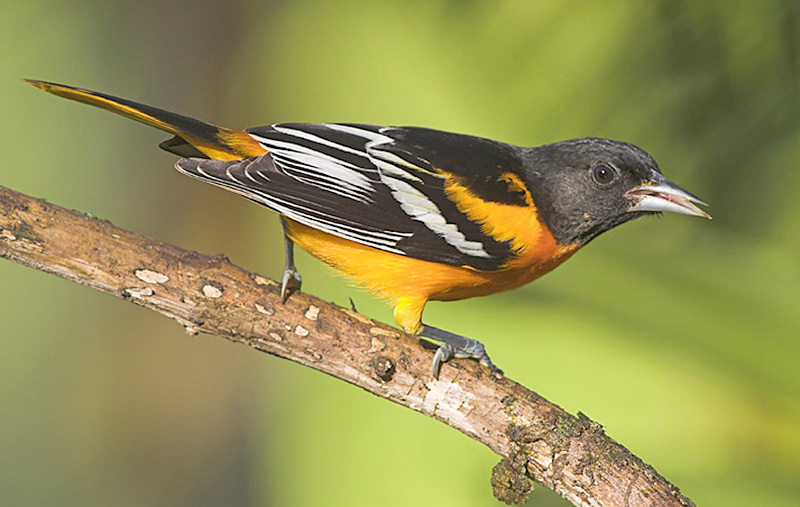
Scientific name: Icterus galbula
Length: 8.75 inches
Weight: 1.2 ounces
Wingspan: 11.5 inches
Song: “turee turee tureeturee tureeturree”
The Baltimore Oriole is a smallish, arboreal blackbird species with a sharp beak. Males have rich orange colors below, and on the shoulders of their wings and tail. They are black above, have a black head, and some white in their wings.
Females and young birds have dull orange on their head, underparts, and tail. They also have dark wings with two pale wing bars.
Baltimore Orioles eat insects, caterpillars, spiders, fruit, and nectar. They forage by moving through trees and picking food from bark and foliage. This bird also likes to eat grape jelly at feeders.
The Baltimore Oriole weaves a distinctive, hanging nest out of grass and other vegetation.
It lives in a variety of wooded habitats, including suburbs and town parks. This bird breeds in much of central and southern Canada and in much of the eastern USA, and winters in tropical habitats from Florida to northern South America and being one of the most common birds of Kansas.
Key Identifications:
- Smallish, orange and black songbird with pale wing bars.
- Forages in trees for insects and at feeders for grape jelly.
- Makes a hanging nest woven out of grass and other bits of vegetation, high in a tree.
- Sings a set of melodious whistled phrases, “turee turee tureeturee tureeturree“. It also makes other brief, whistled calls and a rattling vocalization.
The Baltimore Oriole is an orange and black songbird with some white in its wings. It breeds in various wooded habitats and mostly winters in tropical regions. This species was named after George Calvert (Lord Baltimore), the founder of the Maryland colony whose heraldic colors were pale orange and black.
33. Eastern Meadowlark
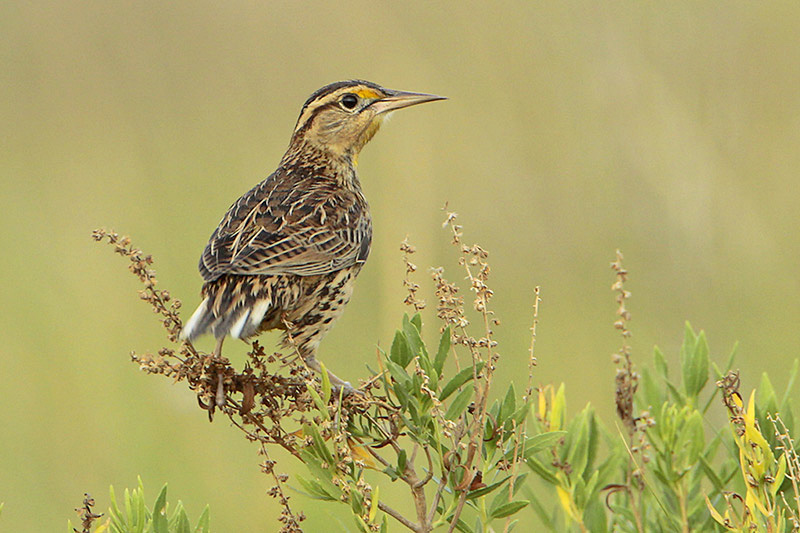
Scientific name: Sturnella magna
Length: 9.5 inches
Weight: 3.2 ounces
Wingspan: 14 inches
Song: “two tee tureeah”
The Eastern Meadowlark is a chunky, robin-sized, blackbird species. Males and females look the same and have mottled, pale-brown upperparts, and a prominent black “V”-shaped mark on their yellow chest.
They also have black and white stripes on their head, a long, sharp beak, and white on the pointed feathers of their rounded tail.
This species also has longish, pale pink legs, and some streaks on its white flanks.
Eastern Meadowlarks mostly eat insects, spiders, and grubs. In winter, they also eat small seeds and some fruit. They forage by walking on the ground in open, grassy habitats and use their beak to probe in the soil, and lift dirt or vegetation to find hidden bugs.
This blackbird species uses grass and other vegetation to make a domed, cup nest on the ground.
The Eastern Meadowlark lives in grassy habitats in southeastern Canada, and from the eastern USA to northern South America, (being one of the most common birds of Kansas)
Key Identifications:
- Chunky, robin-sized, pale brown and yellow songbird with a black “V” mark on its chest.
- Forages for insects and other arthropods on the ground in grassy habitats.
- Sings a pleasant, short song of clear whistles, “two tee tureeah“. It also makes a rattling call and brief, buzzy sounds.
The Eastern Meadowlark is a rotund, pale brown and yellow bird with a black “V” mark on its breast. It lives in open grassy habitats from southeastern Canada south to northern South America. This species used to be considered the same as the Western Meadowlark but these similar species can be separated by their song, habitat, and amount of yellow on their face.
32. Harris’s Sparrow
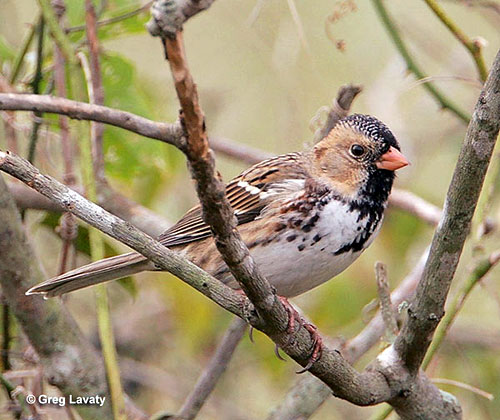
Scientific name: Zonotrichia querula
Length: 7.5 inches
Weight: 1.3 ounces
Wingspan: 10.5 inches
Song: “teee tee tee”
The Harris’s Sparrow is a grosbeak-sized sparrow with a conical pink beak. Breeding adults are gray and mottled brown with black on their throat, upper breast, face, and crown.
They also have two, narrow white wing bars and thick streaks on their flanks. In winter, adult Harris’s Sparrows are more pale brown than gray. They also have reddish streaks on their sides, and white underparts.
Males and females look similar but young birds have a white throat patch with a narrow black outline.
This species eats seeds, berries, conifer needles, and arthropods. It picks food from the ground and while perched in low vegetation. In winter and migration, it can also visit feeders.
This sparrow uses moss, twigs, and lichens to make a cup nest on the ground, underneath a shrub or short tree.
The Harris’s Sparrow breeds in northern Canada where the subarctic boreal forest transitions into tundra. It winters in brushy habitats from Nebraska to central Texas (being one of the most common birds of Kansas).
Key Identifications:
- Good sized sparrow with black on its face and crown, and a pink beak.
- Forages for seeds, berries, and insects on and near the ground.
- Sings a clear, fairly high whistled song of three or four notes, all on the same pitch, “teee tee tee“. It also makes a short, clinking call note, “tink!“.
The Harris’s Sparrow is a gray and brown sparrow with a pink beak and some black on its face, throat, and crown. It breeds in brushy subarctic habitats in northern Canada, and winters in brushy habitats in the central USA. This sparrow is the only songbird species that breeds in Canada and nowhere else.
31. Eurasian Collared-Dove
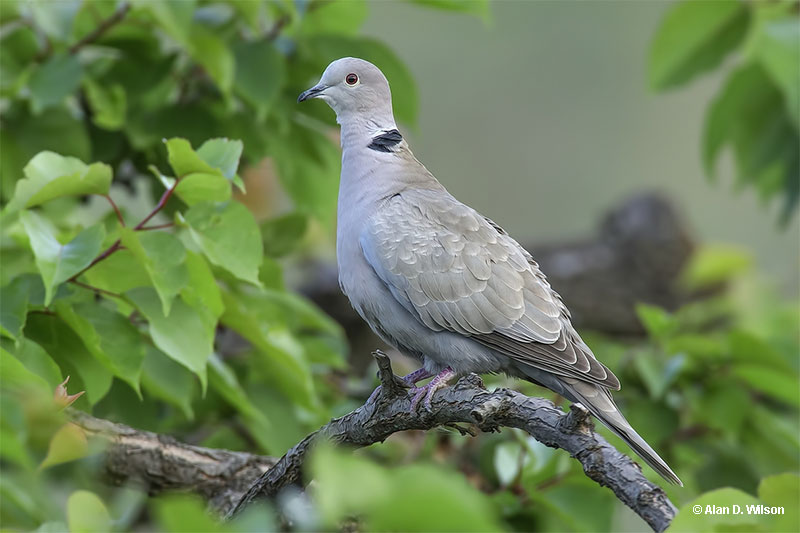
Scientific name: Streptopelia decaocto
Length: 13 inches
Weight: 7 ounces
Wingspan: 22 inches
Song: “hoo hoo hoowuh hoo WUH hoowuh hoo WUH!”
The Eurasian Collared-Dove is a medium to large, pale tan and gray dove with a black mark on its nape. Males and females look similar, have a slender black beak, and a narrow gray eyering.
Eurasian Collared-Doves have black primaries and white in their tail feathers. These field marks are especially visible in flight.
These doves feed on grain and seeds picked from the ground and they can also visit feeders. In some places, Eurasian Collared-Doves occur in large flocks, especially around farms and grain silos.
The Eurasian Collared-Dove makes messy stick nests in trees and on structures near people. This species is highly adapted to living with and near people and prefers to feed in farm fields, gardens, towns, and other places where they can find grain and seeds.
This Eurasian species was accidentally introduced to North America in the 1970s and 1980s. It now occurs in parts of Alaska and much of Canada and the USA, including Kansas.
Key Identifications:
- Fairly large, pale tan and gray dove with black primaries and white in its longish tail.
- Forages for grain and seeds on the ground.
- Makes messy stick nests in gardens, parks, and on farms.
- This dove species often calls and makes a typical dove-like sound, “hoo hoo hoowuh hoo WUH hoowuh hoo WUH!“.
The Eurasian Collared-Dove is a fair-sized pale tan and gray dove with much white in its longish tail. These birds can probably only survive near people and live in gardens, towns, and on farms. When drinking water, this species uses its beak like a straw.
30. Indigo Bunting
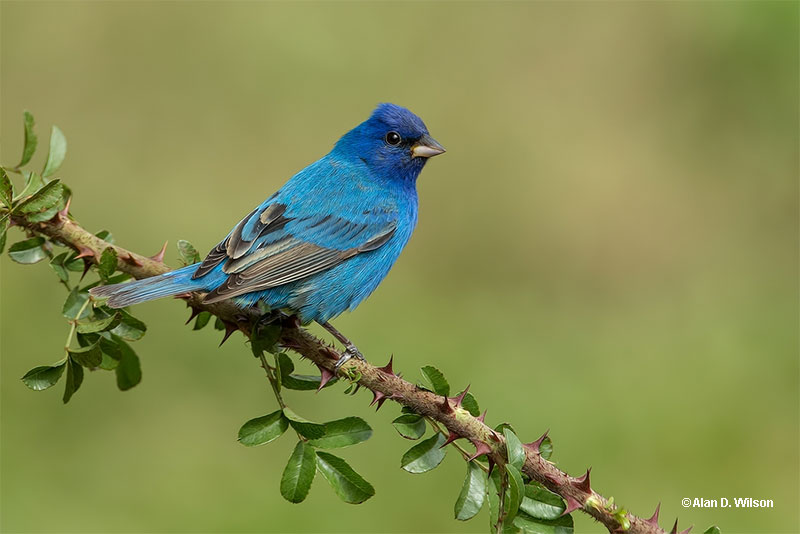
© Alan D. Wilson
Scientific name: Passerina cyanea
Length: 5.5 inches
Weight: .51 ounces
Wingspan: 8 inches
Song: “seet seet, sweet sweet, chip chup, swee sweet”
The Indigo Bunting is a small, finch-like bird with a grayish finch-like beak. Around the same size as a sparrow, males are deep, dark blue birds with some black on their face, wings, and tail.
Females are pale-brown birds with some white on their throat and belly, a hint of a buffy eyering, and two buff wing bars. They also have some faint streaks on their underparts and bits of blue feathers on their rump, wings, and tail.
Indigo Buntings feed on insects, seeds, and some berries. They find food on the ground and also take seeds and berries while perched.
The Indigo Bunting uses grass and other bits of plant matter to make an open cup nest. They build their nests in shrubs and other low, dense vegetation.
This beautiful Kansas bird is a summer resident in forest edge and brushy habitats in southeastern Canada, the eastern and central USA, and in parts of the American Southwest.
Key Identifications:
- Sparrow-sized bird with a finch-like beak. Males are deep, dark blue. Females are mostly pale brown with faint streaks below and some buff highlights.
- Feeds on insects, seeds, and berries in brushy habitats.
- Makes an open cup nest with soft bark and other soft plant matter.
- Often makes a sharp call, “Pik!”. It also sings a halting song, “seet seet, sweet sweet, chip chup, swee sweet“.
The Indigo Bunting is a sparrow-sized, dark blue and black, or pale brown and buff bird of brushy habitats. Male Indigo Buntings appear blue because of the way microscopic structures in their blackish plumage refract and reflect blue light waves.
29. Ring-billed Gull
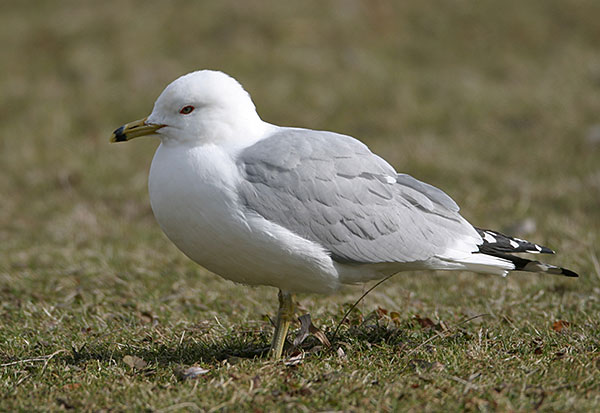
Scientific name: Larus delawarensis
Length: 17.5 inches
Weight: 1.1 pound
Wingspan: 48 inches
Song: “KLEE..KLEEE..kleeya,kleeya,kleeya”
The Ring-billed Gull is a medium-sized pale gray and white gull with a black ring around its yellowish beak. Males and females look the same and have yellowish legs and feet, pale eyes, and black wing tips with a few white spots.
These gulls have direct, fairly quick flight with leisurely wing beats. Young birds have pink and black bills, a white tail with a black tip, and mottled black and gray wings.
Ring-billed Gulls are scavengers and opportunists that feed on carrion, fish, worms, small animals, grain, and other food items. They usually occur in flocks that roam lakes, rivers, urban areas, and other habitats in search of feeding opportunities.
The Ring-billed Gull breeds in colonies, often on islands, and makes a shallow stick nest on the ground.
This gull species occurs not only in Kansas, but also in many parts of Canada and the USA south to Central America.
Key Identifications:
- Medium-sized pale gray and white gull with a black ring on its bill and yellow legs and feet. Juveniles have pink and black beaks.
- Forages for fish, carrion, and many other food items in wetlands and open habitats.
- Nests on the ground, in colonies.
- Ring-billed Gulls often call. In flight, they often make a high-pitched “kleea” sound. On the ground, displaying birds make a loud, laughing, “KLEE..KLEEE..kleeya,kleeya,kleeya“.
Ring-billed Gulls are pale gray and white, medium-sized gulls with a black ring around their beaks and yellow legs and feet. They are well adapted to living with people and occur around lakes, rivers, and other wetlands, parking lots, garbage dumps, and other places. This gull species is a bold bird that can snatch bits of food from unguarded picnic tables.
28. Brown-headed Cowbird
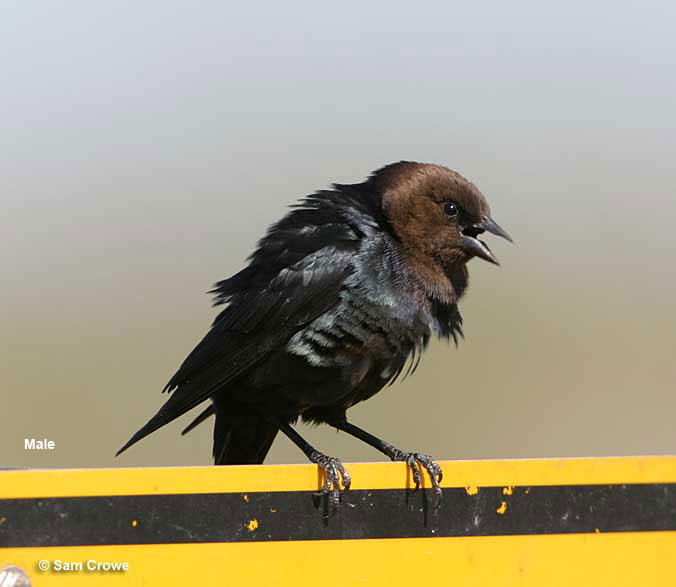
Scientific name: Momothrus ater
Length: 7.5 inches
Weight: 1.5 ounces
Wingspan: 12 inches
Song: “qwuipuh see!”
The Brown-headed Cowbird is a smallish blackbird with a short beak and fairly long wings. Males are glossy black with a dark brown head. Female Brown-headed Cowbirds are dark grayish birds with a dark beak, black eyes, and a white throat.
These small blackbirds forage for seeds and insects on the ground. They usually occur in flocks that forage on pastures and around farms. Cowbirds do most of their foraging with cows, horses, or other large animals to catch insects that the big mammals scare out of hiding.
Brown-headed Cowbirds do not build a nest. Instead, females lay eggs in nests of other birds. Host species can be Northern Cardinals, various warblers, vireos, and many other small birds.
The Brown-headed Cowbird is dependent on cattle, horses, and other large grazing mammals but occurs in a wide variety of habitats. It prefers fields, pasture and other open areas, and lives in southern and western Canada, the USA, and much of Mexico.
Key Identifications:
- Smallish blackbird with a brown head (males) and rather short beak. Females are dark gray with a white throat.
- Flocks forage for seeds and insects on the ground.
- Lays eggs in nests of other birds.
- This species is fairly vocal and often makes a rattling call. Males sing a brief song with bubbly and high-pitched notes, “qwuipuh see!“.
The Brown-headed Cowbird is a smallish blackbird with a short beak and brown head (male), or is gray with a white throat (female). This species flocks together and is very common in pastures and farming areas. Brown-headed Cowbirds have laid their eggs in nests of more than 220 species.
27. Barn Swallow
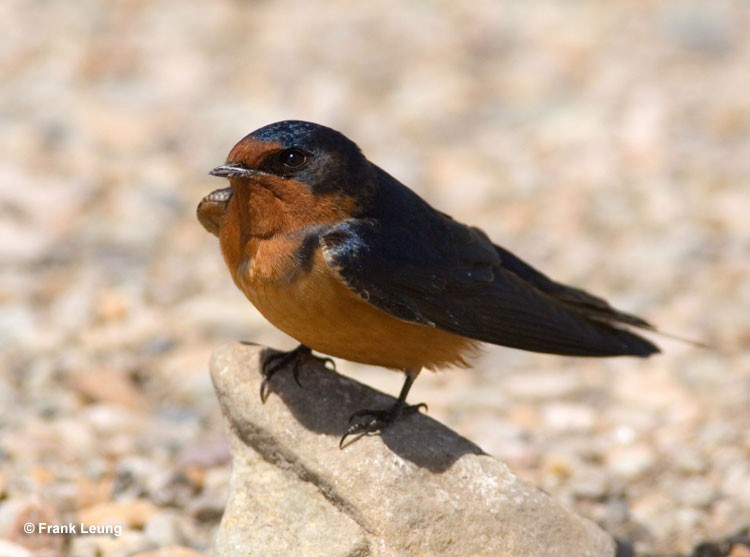
Scientific name: Hirundo rustica
Length: 6.75 inches
Weight: .67 ounces
Wingspan: 15 inches
Song: “chipchipfitfibitchipfibitfwip”
Barn Swallows are small to medium-sized swallows with long forked tails. They are dark, steel-blue above, peach-orange below, and have rich chestnut on the throat and above their bill. It also has some white in its tail.
Males and females look similar but females are paler and have shorter tails. Young birds are like females but their tails are even shorter.
The Barn Swallow is one of the most common birds in Kansas. It has long, pointed wings and fast flight. When flying, they often flap their wings a few times between brief glides.
Barn Swallows live in farming areas, meadows, parks, and other open habitats. They feed on insects as they fly through the air. Although they can fly high overhead, Barn Swallows often swoop low over the ground.
This handsome swallow builds a mud nest on the wall of a barn, bridge, or other structure. Barn Swallows live in large areas of Canada, the USA, Mexico, Europe, and Asia.
Key Identifications:
- Beautiful dark blue and orange swallow with a long, forked tail.
- Forages for insects in flight over fields and other open habitats.
- Constructs a cup nest out of mud in barns and other structures.
- Often makes brief “fwip” calls in flight, and has a long, complex song, “chipchipfitfibitchipfibitfwip”.
The Barn Swallow is a common and easily species in most of its range, and the only swallow with a long, elegant tail. In summer, it is often seen flying low over the ground in open habitats. Barn Swallows are long distance migrants and some fly 5,000 miles, all the way to Argentina!
26. Eastern Bluebird
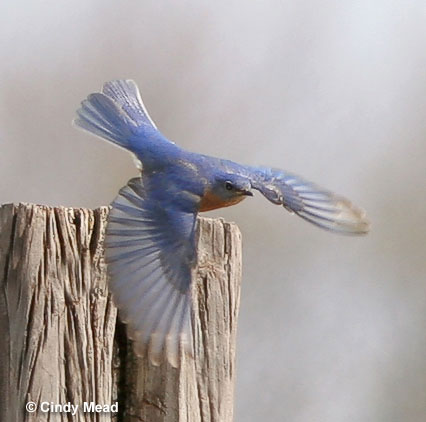
Scientific name: Sialia sialis
Length: 7 inches
Weight: 1.1 ounces
Wingspan: 13 inches
Song: “fer fer chidip fer”
The Eastern Bluebird is a rather small, blue and white bird with orange on the side of its neck, throat, breast, and flanks. The male has beautiful pastel blue upperparts, and a white belly and undertail.
Females have blue-gray upperparts, a broken white eyering, and some white on the throat.
Juveniles are gray-brown with some blue and pale spotting.
The Eastern Bluebird feeds on insects, fruit, and occasional seeds. It snatches insects in flight, picks them from leaves while hovering, and flies down to meadows and grassy areas to catch them on the ground.
Flocks of Eastern Bluebirds feed on small fruits by perching in fruiting trees and picking them from vegetation.
Eastern Bluebirds make a shallow cup nest out of grass inside a tree cavity or nest box.
This beautiful bird lives in open and semi-open habitats in southern Canada and the USA east of the Rocky Mountains. They also live in mountains in Mexico and northern Central America (including Kansas).
Key Identifications:
- Smallish blue and white bird with orange on their throat, breast, and flanks.
- Forages for insects and small fruit.
- Makes a shallow cup nest out of grass in a nest box or tree cavity.
- Has short melodious calls, “jeer” and a song of similar melodious notes, “cheweer chewit cherwit“.
The Eastern Bluebird is a smallish, blue and white thrush with orange highlights. They live in open and semi-open areas, and, in winter, form flocks that feed at fruiting trees. Eastern Bluebird populations have been boosted in many areas by “Bluebird Trails”; areas with nest boxes designed for this species.
25. Common Grackle
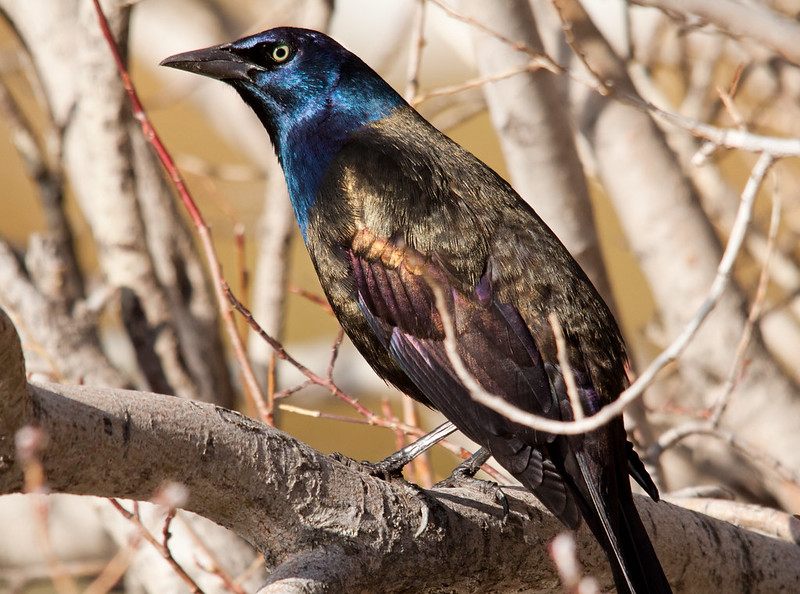
© Shawn McCready
Scientific name: Quiscalus quiscula
Length: 12.5 inches
Weight: 4 ounces
Wingspan: 17 inches
Song: “Sherink!”
The Common Grackle is a jay-sized, glossy black bird with pale eyes and a long, wedge-shaped tail. Depending on lighting, this bird shows metallic purple, blue, green, and bronze highlights.
Males and females look very similar but females have shorter tails and less iridescence. Both sexes also have stout, black beaks, and strong, black legs and feet.
In flight, Common Grackles move up and down as they move through the air. They usually flock together and often forage in farm fields, on lawns, and in other open habitats. These omnivores feed on a variety of items including insects, seeds, grain, small animals, garbage, and the eggs and nestlings of other birds.
Common Grackles build bulky stick nests, usually in conifers in woodlands, parks, near water, and urban areas.
This species can form big flocks in the winter and lives in a variety of semi-open and open habitats in eastern Canada and the eastern USA.
Key Identifications:
- Fairly large, black bird with glossy purple, greenish, bronze, or dark blue highlights. It also has pale eyes and a long, wedge-shaped tail.
- Forages for insects, seeds, and other food on the ground in a variety of open habitats.
- Constructs a bulky cup nest in a conifer.
- Common Grackles are vocal birds. They frequently give raspy, metallic calls, “Sherink!”, and “kek” calls.
The Common Grackle is a common, glossy black bird with pale eyes. It usually occurs in flocks in open and park-like habitats. This species occasionally nests in odd places, including occupied nests of Great Blue Herons and Ospreys!
24. Killdeer
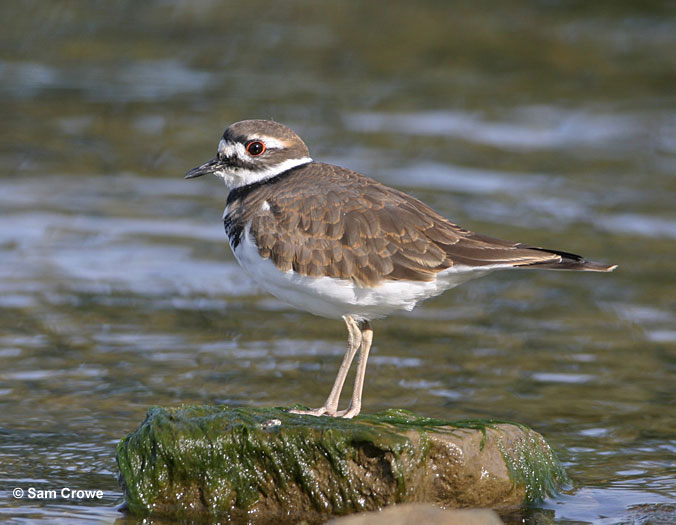
Scientific name: Charadrius vociferus
Length: 10.5 inches
Weight: 3.3 ounces
Wingspan: 24 inches
Song: “tideer, tideer, tideer, tideer”
The Killdeer is a fair-sized, slender plover that is dark brown above and white below. They have two black bands on their breast, a patterned, black, white, and dark brown face, and a longish, orange tail.
Both sexes look alike and also have a slender, black bill, narrow, red-orange eyerings, and long, pale legs. In flight, we can see a white stripe in each of their long, dark wings, and a black tip on their long, wedge-shaped, orange tail.
Killdeers often fly high overhead in fast, direct flight but we usually see them foraging on the ground. They pick insects, other small creatures, and seeds from the edges of wetlands and other, open grassy areas.
This species lays its camouflaged eggs on the ground, in gravel and open fields. When people and pets approach too close, they give loud calls and pretend to have a broken wing.
The Killdeer lives in large parts of Canada, the USA, Mexico and also Kansas.
Key Identifications:
- Fair-sized plover with two black breast bands and a wedge-shaped orange tail with a black tip.
- Picks seeds and small creatures from open ground.
- Lays camouflaged eggs on the ground, in gravel and open fields.
- Very vocal and sounds like it says its name, “tideer, tideer, tideer, tideer”.
The Killdeer is the most common and familiar shorebird in much of its range and occurs in many open habitats. It is the only plover in North America with two black breast bands and has a longish, orange tail with a black tip. To scare cows near their nests, Killdeers fluff themselves to look bigger, raise their tail over their head, and run at the large animal.
23. Mallard
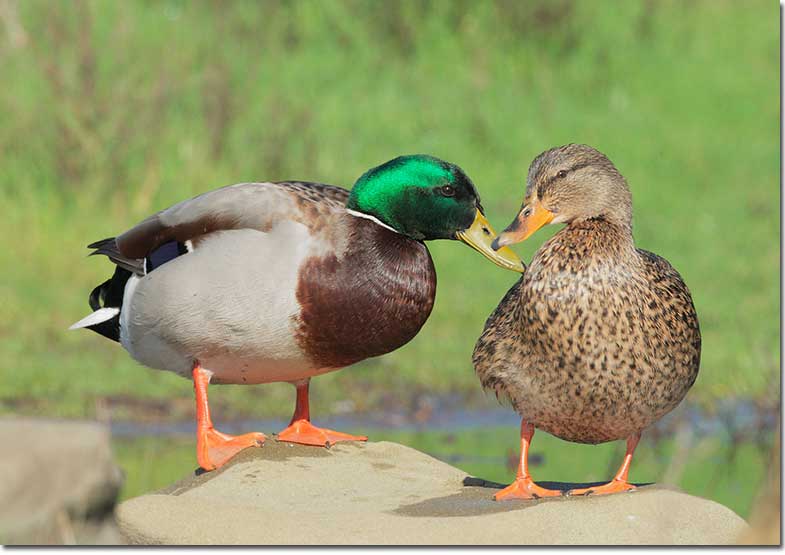
Mallard pair (Male and female)
Scientific name: Anas platyrhynchos
Length: 23 inches
Weight: 2.4 pounds
Wingspan: 35 inches
Song: “quack, quack”
The Mallard is a fairly large, familiar duck. The male has a metallic green head, yellow bill, narrow white ring around the neck, and chestnut breast. The rest of the bird is pale gray with pale brown, and black on its back and around his tail.
Female Mallards are mottled brown and buff with a dark crown and line through the eyes, and have a dark gray and orange beak.
In flight, both sexes show a green-blue wing patch bordered with white.
Mallards eat a variety of items including insect larvae, snails, other small aquatic creatures, acorns, seeds, and grain. They forage by filtering and picking up food items in and near shallow water, and in farm fields.
This Kansas duck species makes a shallow nest with sticks and lined with down feathers. It builds its nest on the ground, hidden in grass or under a bush.
The Mallard lives in ponds, marshes, and many wetland habitats in Canada, USA, and Eurasia.
Key Identifications:
- Feeds on insect larvae, grain, seeds, and other items picked up with its bill in and near shallow water.
- Makes a shallow stick nest hidden in grass or under a bush.
- The female Mallard makes the classic “quack, quack” duck sound. Males make similar but softer sounds and a whistling call.
The Mallard is a fairly large and familiar duck with a dark green head (the male), or is buff and brown with a dark gray and orange beak (the female). Thus duck species often lives near people and occurs on lakes, ponds, and other wetlands. No matter how different they look, most small domestic duck species are descended from wild Mallards.
22. White-breasted Nuthatch
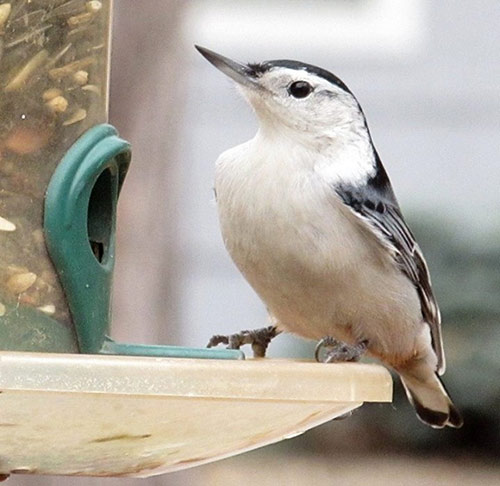
Scientific name: Sitta carolinensis
Length: 5.75 inches
Weight: .74 ounces
Wingspan: 11 inches
Song: “wehn wehn wehn wehn wehn wehn wehn wehn”
The White-breasted Nuthatch is a sparrow-sized bird with a longish, sharp, slightly upturned beak and a short black and white tail. It also has long wings, is mostly blue-gray above, and white and gray below with some chestnut on its belly and undertail.
Both sexes look similar and have a white face but males have a black cap and nape. Females have gray on their head and nape.
This small bird forages for insects, nuts, and seeds by creeping along branches and going down trunks, head-first. It uses its beak to pick food items from bark and also visits feeders.
The White-breasted Nuthatch makes a cup nest out of grass and soft bark inside a tree cavity or nest box.
White-breasted Nuthatches live in various wooded habitats in parts of southern Canada, most of the USA, and mountains in Mexico. They are frequent visitors to gardens near woodlands.
Key Identifications:
- Sparrow-sized, short-tailed songbird that is blue-gray above, mostly white below, and has a longish, slightly upturned beak.
- Creeps on branches and down tree trunks for insects, nuts, and seeds. Also visits feeders.
- Uses grass and soft bark to make a cup nest in a tree cavity or nest box.
- Quite vocal and makes nasal calls “yank yank“, and sings a nasal, laughter-like song, “wehn wehn wehn wehn wehn wehn wehn wehn“.
White-breasted Nuthatches are small blue-gray and white birds with slightly upturned beaks. They creep down trees in many wooded areas and are regular visitors to feeders. This species prefers to forage in flocks with chickadees and titmouse species because they are good at finding food and quick to make alarm calls when they see a predator.
21. Great Blue Heron
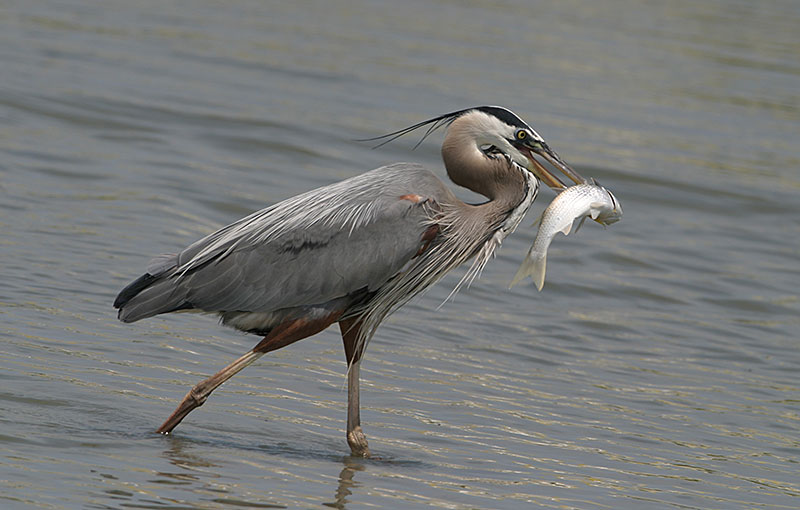
Scientific name: Ardea herodias
Length: 46 inches
Weight: 5.3 pounds
Wingspan: 72 inches
Song: “Grunk! Grunk!”
The Great Blue Heron is a large, gray and pale brown heron with a long neck and legs. It has a strong, yellowish beak, black and white head with a wispy black crest, and rufous thighs.
Both sexes are alike and have pale bellies and black flanks. Juveniles have streaked underparts.
In flight, they make slow, deep flaps with long, broad gray and black wings. In Southern Florida and the Caribbean, Great Blue Herons are all white and sometimes considered a separate species, the “Great White Heron”.
These powerful herons feed on fish and small animals such as rats, snakes, and birds.
Great Blue Herons build messy, stick nests and breed in colonies, often in swamps.
We find these impressive birds in and near a wide variety of wetlands in large parts of Canada, the USA, and the Caribbean.
Key Identifications:
- Huge gray and pale brown wading bird with a thick, yellowish beak and a wispy crest. In southern Florida, it is all white but still has a crest and a strong yellowish beak.
- Stalks and preys on fish and small animals.
- Builds messy stick nests and breeds in colonies.
- Great Blue Herons aren’t all that vocal. When taking flight they make a croaking sound, “Grunk! Grunk!“.
The Great Blue Heron occurs on rivers, lakes, and many other wetlands. It stands still for long periods of time while waiting for prey to come within range of its sharp beak but is also, often seen in flight. In some parts of Florida, Great Blue Herons have a gray and brown body and a white neck and head. These birds are known as, “Wurdemann’s Heron”.
20. Turkey Vulture
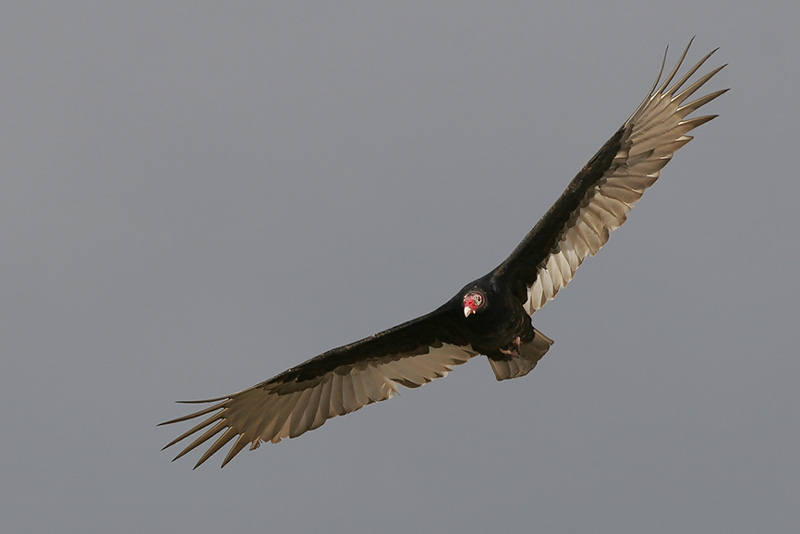
Scientific name: Cathartes aura
Length: 26 inches
Weight: 4 pounds
Wingspan: 67 inches
Song: “hisss”
The Turkey Vulture is a big, dark brownish-black raptor with a small red head and long, broad wings. Males and females look alike and also have a longish tail.
In flight, the way Turkey Vultures soar is one of the best ways to recognize them. They fly with their wings held in a “V” shape and, when gliding, often rock back and forth.
Their flight feathers are also paler than the rest of their wings but they lack the Black Vulture’s white wing patch.
Turkey Vultures are scavengers and most of their diet is carrion. They eat road kill and a wide variety of dead animals. This species forages over every type of habitat and can also fly over urban areas.
It lays two eggs on the ground in caves and hollow logs.
The Turkey Vulture lives in southern Canada and in most of the USA south to southern Argentina.
Key Identifications:
- Big, dark raptor with a small red head that soars with long wings held in a “V”.
- Feeds on dead animals.
- Nests on the ground in caves and hollow logs in secluded areas.
- Turkey Vultures rarely call and mostly make hissing sounds at their nest.
The Turkey Vulture is commonly seen flying over every type of habitat. They are often seen on their own but can occur in flocks, especially during migration. Unlike most other birds, this species uses its amazing sense of smell to find dead animals.
19. Red-Tailed Hawk
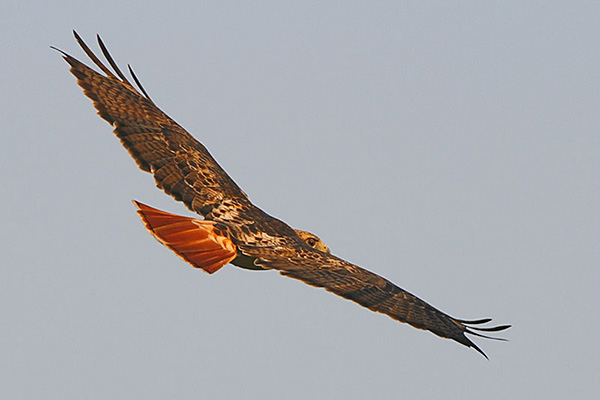
Scientific name: Buteo jamaicensis
Length: 19 inches
Weight: 2.4 pounds
Wingspan: 49 inches
Song: “Kreeeyahh!”
The Red-tailed Hawk is a large and chunky raptor with a broad, orange or reddish tail. Males and females look alike although females are larger.
These raptors are dark brown above and are pale below with dark markings on their belly. Young birds are more streaked on their underparts, and have brown tails with dark barring.
Red-tailed Hawks often soar and have long, broad wings that can show pale square patches on the bases of their primaries. While soaring, they watch for squirrels and other small animals that they feed on.
When they spot prey, these big birds drop down to catch it with their talons. This hawk also hunts by watching for prey from a perch.
The Red-tailed Hawk builds a large, bulky, stick nest high in trees. They thrive in a wide variety of habitats but especially in woodlands near fields and other open habitats.
This raptor lives from Alaska and Canada south to Central America.
Key Identifications:
- Large, bulky hawk with a broad, reddish tail.
- Catches squirrels, rats, pigeons, and many other small animals on the ground.
- Nests in large, bulky nests made of sticks.
- A vocal raptor, Red-tailed Hawks often call in flight. They usually give a “classic” but quiet sounding raptor scream, “Kreeeyahh!“.
Red-tailed Hawks are large dark brown and pale hawks with broad, reddish tails. The most common raptor in many areas, they often perch on powerline poles along roads. The Red-tailed Hawk’s vision is eight times better than a person’s; they can spot a tiny rodent while soaring 100 feet above it.
18. Northern Flicker
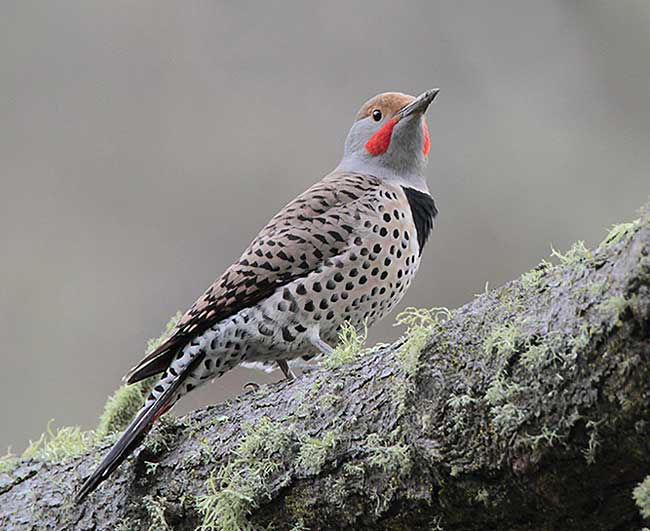
Scientific name: Colaptes auratus
Length: 12.5 inches
Weight: 4.6 ounces
Wingspan: 20 inches
Song: “kick,kick,kik,kik,kik.kik.kik.kik.kik.kik.kik.kik!”
Northern Flickers are fairly large, tan and gray woodpeckers with barring on their backs. They have a black mark on their breast, black spotting below, and a dark, stout beak.
Males in the east have a tawny throat and face with a black moustache and small red spot on the back of their heads. Males in the west have mostly gray heads with a red moustache.
Female Northern Flickers look like males but lack the moustache mark.
In bounding flight, they have white rumps and flash color on their underwings. This is bright yellow in eastern birds and reddish in flickers west of the Rocky Mountains.
This woodpecker eats many ants and other insects that it catches on the ground. It forages by flying to the ground, locating anthills, and lapping them up with its long tongue.
Northern Flickers nest in tree cavities and live in wooded and open habitats in Canada, the USA, and Mexico.
Key Identifications:
- Tan and gray woodpecker with black barring above, black marks below, and a bright, white rump.
- Forages for ants and other insects on the ground.
- Nests in tree cavities.
- A vocal woodpecker, the Northern Flicker often gives loud, “flicka,flicka,flicka” calls, and another loud, single note that sounds like, “Keer!” They also have a long, laughing vocalization of repeated notes, “kick,kick,kik,kik,kik.kik.kik.kik.kik.kik.kik.kik!“.
Northern Flickers are fairly big, tan woodpeckers with gray highlights, a white rump, and black markings. They mostly forage for ants on the ground in open and wooded areas. The red-shafted Northern Flickers in the west used to be considered a separate species from the yellow-shafted flickers of the east. At present, they are considered to be one species because they frequently hybridize with each other.
17. Carolina Wren
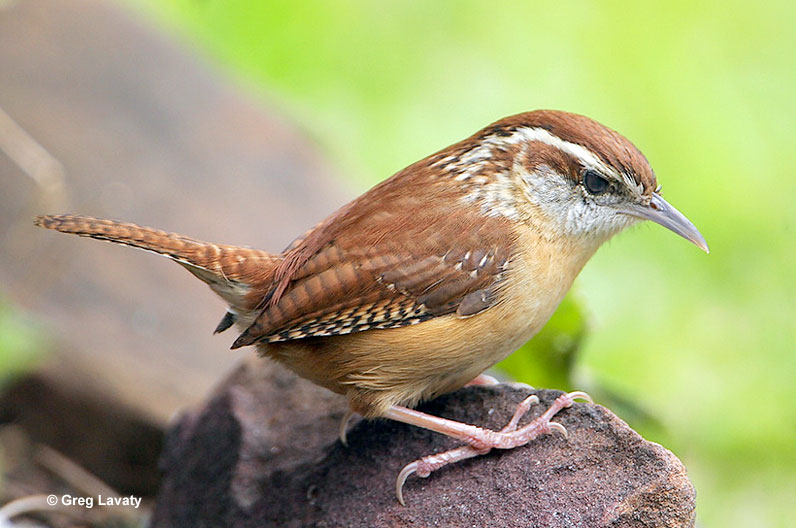
Scientific name: Thryothorus ludovicianus
Length: 5.5 inches
Weight: .74 ounces
Wingspan: 7.5 inches
Song: “teakettle, teakettle, teakettle”
The Carolina Wren is a small, reddish-brown and buff bird with a long, sharp, slightly decurved beak. It has a long, narrow, white eyebrow, a white throat, and some white mottling on its face. Males and females are similar and have black barring on their short wings, long tail, and under the tail.
Juveniles are similar but have paler underparts. This animated and vocal little bird forages for bugs in vine tangles and other dense vegetation. It usually occurs in pairs that can easily hide in the dense vegetation they prefer.
Carolina Wrens build a domed, cup nest made of sticks and soft vegetation. There is a side entrance and it can be placed in cavities and crevices of stumps, bushes, trees, potted plants, and other structures.
The Carolina Wren lives in vegetated gardens, second growth, parks and similar habitats in much of the eastern USA, parts of southern Ontario, and parts of eastern Mexico.
Key Identifications:
- Small reddish-brown and buff bird with a long beak and long white eyebrow.
- Feeds on arthropods in dense, tangled vegetation.
- Makes a domed cup nest with a side entrance in crevices, tree cavities, and human-made structures.
- Carolina Wrens fill the garden with loud and melodious songs. One common song sounds like, “teakettle, teakettle, teakettle“. They also make trilled sounds and harsh, nasal calls.
The Carolina Wren is a vocal species of gardens and second growth. Pairs use their long beaks to catch bugs and insects and aren’t shy about nesting near people. Many of these friendly birds have nested in such places as old shoes, potted plants, and abandoned cars.
16. Red-winged Blackbird
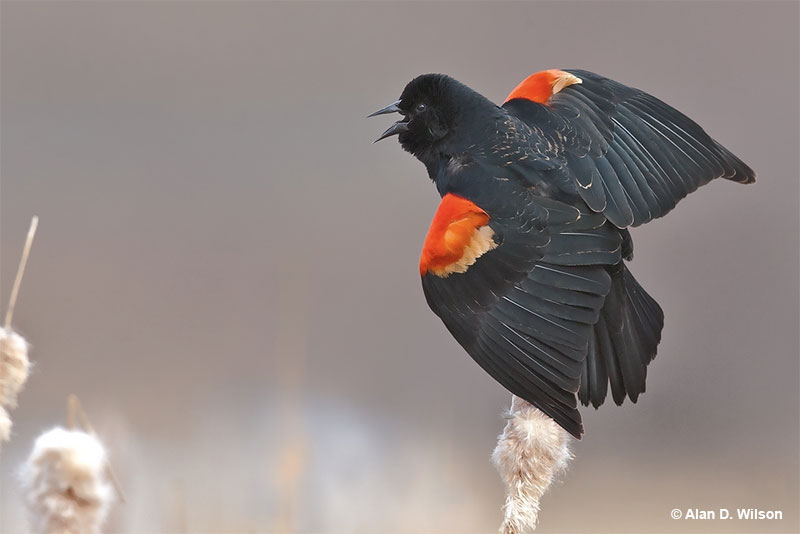
Scientific name: Agelaius phoeniceus
Length: 8.75 inches
Weight: 1.8 ounces
Wingspan: 13 inches
Song: “kan-keree!”
The Red-winged Blackbird is a medium-sized blackbird species with a sharp, all black bill. Males also have a scarlet patch with a pale yellow border on the shoulder of each wing.
Female Red-winged Blackbirds are dark, heavily streaked, brownish-gray birds with an orange-buff eyebrow and throat. She can also have a little bit of dingy red on her shoulder.
Red-winged Blackbirds often flock together and can form very large groups in the winter. They feed on seeds, grain, and insects found on lawns, in marshes, farm fields, and other open habitats.
This species builds a cup nest made of leaves and dead stems in a bush or other low vegetation in a marsh, park, or brushy field.
Red-winged Blackbirds are very common birds that live in all sorts of open habitats. We see them in parks, farming areas, and marshes in much of Canada, the USA, Mexico, and parts of the Central America.
Key Identifications:
- Males are medium-sized blackbirds with a bright red patch on their wings. Females are heavily streaked, have a sharp black beak, and buff on the head.
- Feeds on seeds, grain, and insects on the ground in many open habitats.
- Builds a cup nest in a bush or other low vegetation.
- Red-winged Blackbirds often call. Males sing a loud, “kan-keree!” and both sexes also make “check!” calls and a high-pitched whistle-like sound.
The Red-winged Blackbird is a common, social species easily seen in marshes and open habitats. In the winter, it can form huge flocks that feed in farm fields. This species can make a daily commute of 50 miles to and from roosting and feeding sites.
15. Dark-eyed Junco
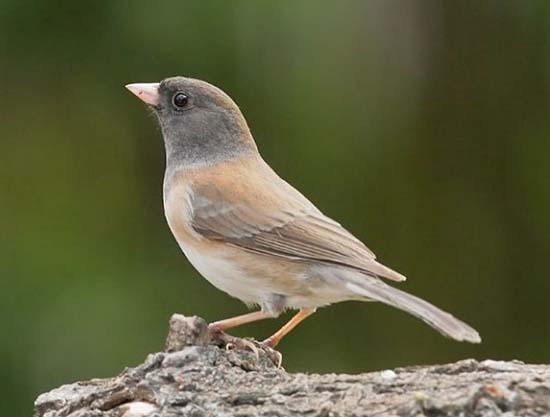
Scientific name: Junco hyemalis
Length: 6.25 inches
Weight: .67 ounces
Wingspan: 9.25 inches
Song: “sipsipsipsipsipsipsip”
Dark-eyed Juncos are sparrow-like birds with pale conical bills and dark eyes. This small bird has variable plumage with most being slate gray or gray and brown with white on their bellies, and white under their tails.
Other plumages include birds with dark masks and faint white wing bars, juncos with pale gray hoods and pinkish sides, and birds with blackish hoods and chestnut sides.
In flight, all Dark-eyed Juncos show extensive white in their longish tails.
This species feeds on seeds, insects, and some fruit and grain. Juncos forage on the ground in wooded areas, parks, and other habitats. They also feed on fallen seed beneath feeders.
They build cup nests on the ground under fallen logs, in roots, and other hidden spots. After breeding, juncos form flocks that forage together in similar wooded and semi-open habitats.
Dark-eyed Juncos are common birds in Canada, the USA, and parts of Mexico.
Key Identifications:
- Sparrow-like gray and brown bird with dark eyes, a pale beak, and white in the tail.
- Forages for seeds and insects on the ground, can feed on seeds at and beneath feeders.
- Builds a cup-shaped nest on the ground in tree roots, under logs, and other hidden places.
- This species often makes a sharp, high-pitched chip note, “pik!”. On breeding grounds, males sing a short, plain trill, “sipsipsipsipsipsipsip“.
Dark-eyed Juncos are sparrow-like, gray and brown birds with much white in the tail. Common wintering birds in many areas, they forage for seeds on the ground in wooded and park-like habitats. In many places, this common species is also known the “Snowbird” on account of only occurring in the winter months and having white on the belly and tail.
14. House Sparrow
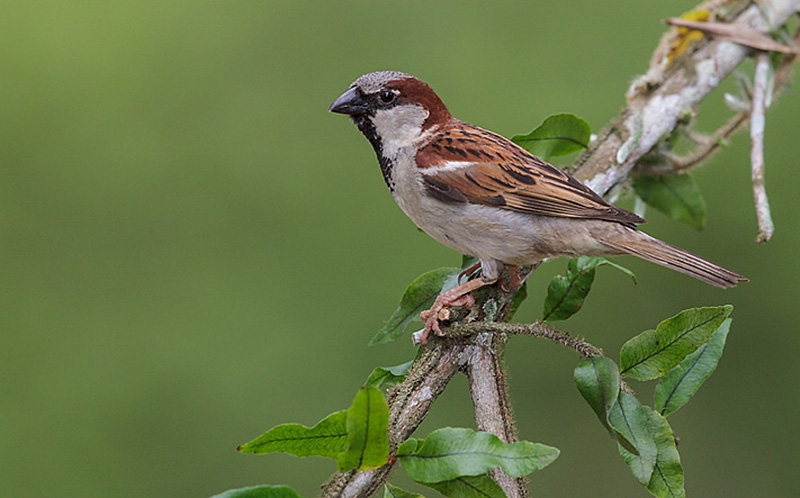
House Sparrow (Passer domesticus) perched on a branch in the Atlantic rainforest of southeast Brazil.
Scientific name: Passer domesticus
Length: 6.25 inches
Weight: .98 ounces
Wingspan: 9.5 inches
Song: “see,chirrup,see,chirrup,see,chirrup”
House Sparrows are small, plump gray and brown birds with conical, finch-like beaks. Males have a gray and rufous head with pale cheeks, and black near their eyes and on their throat.
The rest of their underparts are gray and they have brown, streaked backs with rufous highlights. They also have a white mark in the shoulder of each wing and a grayish rump and tail.
Females are plainer brown and buff, have paler beaks, and buff eyebrows.
House Sparrows feed on seeds, grain, and insects. They are regular visitors to bird feeders and often dominate other smaller species. They also forage on the ground in farmlands, parks, urban areas, and other open situations.
The House Sparrow nests in cavities. When searching for suitable nesting sites, they can kill and remove the eggs and young of smaller species like Eastern Bluebirds.
House Sparrows usually live near people and occur in most of North America, including Kansas.
Key Identifications:
- Brown and gray sparrow with a bold pattern on its head.
- Feeds on seeds, grain, and insects at feeders and on the ground in urban areas and farmlands.
- Nests in tree cavities, including nest boxes.
- This species is vocal and often makes short chirping calls. Its song is a friendly series of chirping sounds, “see,chirrup,see,chirrup,see,chirrup”.
In many places, the House Sparrow is the common urban sparrow. It occurs in pairs and small groups that forage on sidewalks, in parking lots, farm fields, and other familiar places. This species is one of the very few birds that has evolved to live with people and digest the same grains that we eat.
13. Tufted Titmouse
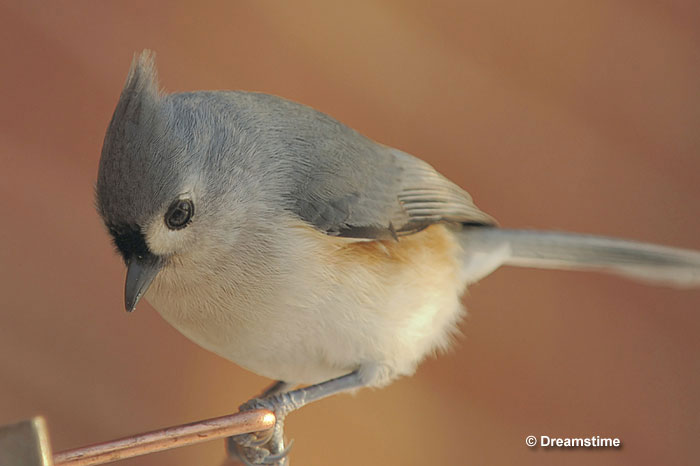
Scientific name: Baeolophus bicolor
Length: 6.5 inches
Weight: .75 ounces
Wingspan: 9.75 inches
Song: “peter peter peter”
The Tufted Titmouse is a small, crested, blue-gray bird with a white face. Males and females look the same and have a small black mark above their stubby black beak. They also have pale underparts with peach-orange flanks.
These cute little birds occur in small groups that forage for insects and seeds in parks and woodlands. They move through the trees and use their bills to pick food from leaves, bark, and branches. Tufted Titmouse are also regular visitors to bird feeders.
These small birds nest in woodpecker holes and other cavities in dead trees, and can also use nest boxes.
We find the Tufted Titmouse in hardwood forests and forested urban areas. They are often heard before they are seen, and flock with other small birds. When they see a predator, they are some of the first birds to harass it.
The Tufted Titmouse occurs in the eastern USA and some parts of southeastern Canada.
Key Identifications:
- Small, crested blue-gray bird with pale underparts and a white face.
- Feeds on seeds and insects and visits feeders.
- Nests in tree cavities and nest boxes.
- The Tufted Titmouse is a very vocal bird. It gives constant whistled calls over and over, “peter peter peter“.
The Tufted Titmouse is an easily recognized bird that lives in parks, gardens, and woodlands. It occurs in small flocks, often visits feeders, and needs dead trees or nest boxes to breed. This species lines its nest with mammal hair including fur from Raccoons, Opossums, and other animals.
12. Canada Goose
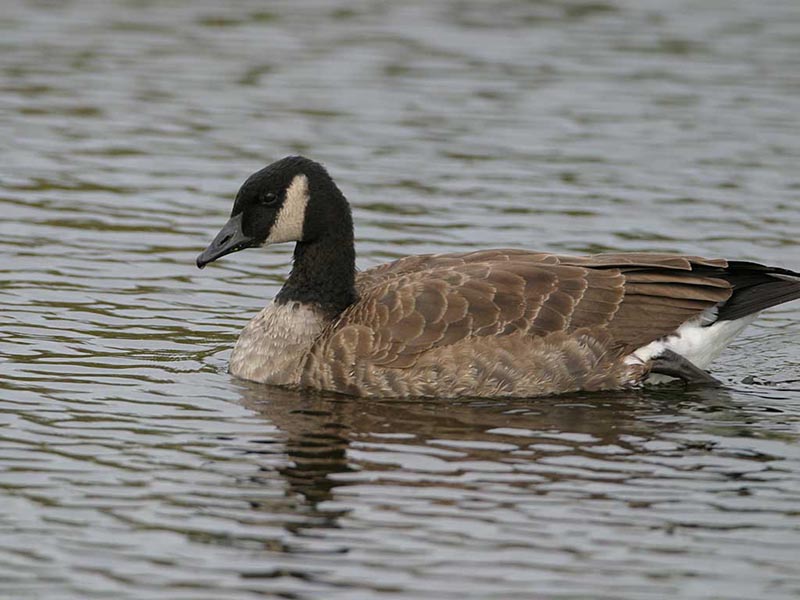
Scientific name: Branta canadensis
Length: 35 – 45.2 inches
Weight: 5.29 – 19.8 pounds
Wingspan: 50 – 67 inches
Song: “uurrRUNK! uurrRUNK!”
The Canada Goose is a large, grayish-brown bird with a long black neck, and black head with a white throat and cheeks. Males and females look alike and have pale barring, a white belly and undertail, and a short black and white tail.
They have strong direct flight and make deep flaps with long, broad wings.
Canada Geese feed on grass, sedges, and other vegetation, grain, and berries. They forage by walking along and grazing, or picking food from the ground and bushes. This species also feeds by dipping its head below the surface of shallow water.
This large goose uses grass and other plants to make a large, shallow cup nest on a small mound or other elevated spot next to water.
The Canada Goose prefers open grassy areas and farm fields near water where it can feed and see predators before they get too close. They live in Alaska, most of Canada, and most of the USA, being one of the most common birds of Kansas.
Key Identifications:
- Big, gray-brown goose with a long black neck, and black and white head.
- Grazes vegetation and forages for berries in wide open, grassy habitats near water like golf courses, parks, and airports.
- Makes a shallow, open cup nest on an elevated spot next to water.
- Vocal and often makes honking calls, “uurrRUNK! uurrRUNK!“.
Canada Geese are a large, common goose species with long black necks, and a black and white head. These big birds are a common sight on golf courses and other places that combine open lawns and water. When the Canada Goose and other birds migrate in “V” formation, they expend less energy than flying on their own.
11. European Starling
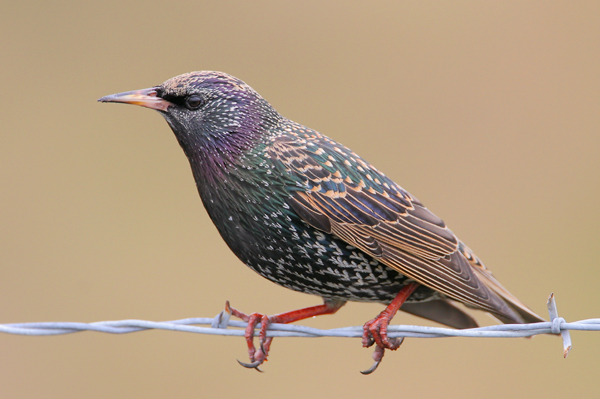
Photograph © Greg Lavaty.
Scientific name: Sturnus vulgaris
Length: 8.5 inches
Weight: 2.9 ounces
Wingspan: 16 inches
Song: “tiktiktitZHREEree..tiktiktik..ZHREE”
European Starlings are plump, short-tailed birds with long sharp beaks and longish, pointed wings. In summer, they have yellow beaks, glossy black plumage with purple and green highlights, and some small white spots.
Males and females are similar but males have less spotting and glossier plumage. In winter, they have black beaks, white spots, and more reddish colors in their wings.
Young starlings are shaped like adults but are grayish birds with a dark beak and a pale throat.
This species feeds on a variety of insects, fruit, and seeds. They can dominate bird feeders and are common species in urban areas, parks, farmlands, and other open habitats.
This European Starling builds a soft cup nest in a tree cavity, nest box, or suitable cavity in other structures.
European Starlings flock with each other and blackbird species, especially during the winter. They live across a large part of Canada and the USA.
Key Identifications:
- Rotund, short-tailed bird with a long, sharp beak, and pointed wings. Glossy black with some spotting in the summer and blackish with heavy white spotting and streaking in the winter.
- Feeds on seeds, fruit, and insects. Visits feeders and forages on the ground in flocks.
- Builds a soft cup nest in nest boxes and other cavities.
- The European Starling makes a wide variety of mechanical and whistled sounds. They also mimic other birds and sounds in their environment. They sing long, jumbled mechanical-sounding songs, “tiktiktitZHREEree..tiktiktik..ZHREE”.
European Starlings are rounded, blackish birds with long, sharp beaks and short tails. They live in towns, cities, parks, on farms, and in other open habitats. This species forms large flocks called, “murmurations” that move in coordinated patterns.
10. American Goldfinch
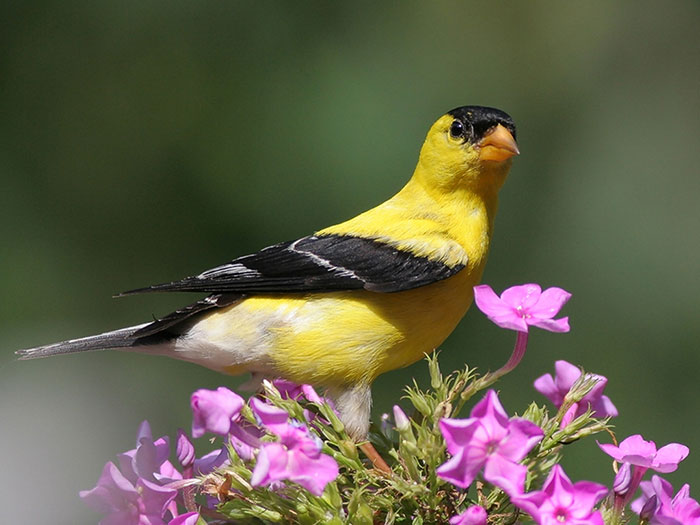
Scientific name: Carduelis tristis
Length: 5 inches
Weight: .46 ounces
Wingspan: 9 inches
Song: “swit sweet, sipsipsipchichisweetsweet”
The American Goldfinch is a small, sparrow-sized finch with a black and white, slightly forked tail, pale rump, and white undertail. In summer, males are bright lemon yellow with a small black cap, pale beak, and have some white markings on long black wings.
Females and wintering birds have two pale wings bars and have plain gray, buff, and yellowish plumage. This species often occurs in small flocks and has bounding flight.
American Goldfinches feed on seeds. They forage by picking them from grass, thistle, other low plants, Alders, and other trees. Goldfinches are also frequent visitors to bird feeders.
The American Goldfinch uses plant matter and other soft materials to build a small, tightly woven cup nest high in a shrub or a low tree.
American Goldfinches are summer residents in southern Canada, California, and the northern half of the USA, and winter in most of the USA and parts of Mexico.
Key Identifications:
- Small, bright yellow finch with a black cap, wings and tail (summer male), female and winter males are plain brown, buff, and yellowish birds with two pale wing bars.
- Feeds on seeds in low plants, trees, and at feeders.
- Makes a tightly woven cup nest high in a shrub or low tree.
- Often gives a “per chickory” call in flight and sings a short, trilled song, “swit sweet, sipsipsipchichisweetsweet“.
American Goldfinches are small, common finches that frequent weedy and brushy fields, second growth, parks, and backyards. Outside of the breeding season, they occur in small flocks and often visit feeders. Brown-headed Cowbirds that hatch in American Goldfinch nests die after a few days because they can’t survive on a diet of seeds.
9. House Finch
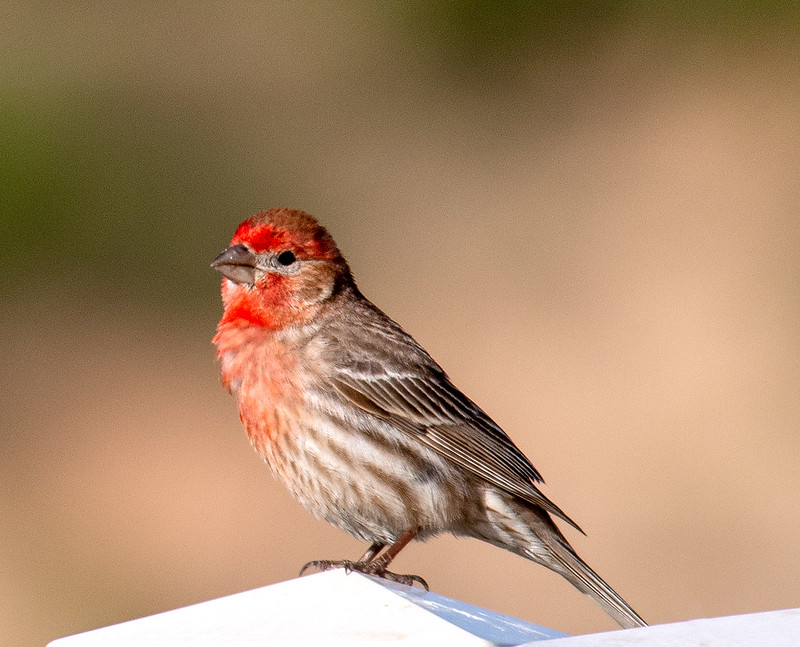
Photograph © John Hansen
Scientific name: Haemorhous mexicanus
Length: 6 inches
Weight: .88 ounces
Wingspan: 10 inches
Song: “chip,chip,chiprididip,ZREEYachip”
House Finches are sparrow-sized birds with dark, rounded beaks and fairly long wings. Males are orange-red or rose-red on their head, throat and breast, and have some red on their rump. They also have brownish streaks on their back, flanks, and white belly.
Like the male, female House Finches have two white wing bars on long, gray-brown wings. However, they lack red and are mostly streaked, dull brown-gray birds.
House Finches feed on seeds, buds, fruit, and flowers. They often visit feeders in Kansas but also forage on the ground, and in bushes and trees.
We see these pretty birds in deserts and arid zones, and in parks, farmland, urban areas, and other semi-open habitats.
The House Finch makes a soft cup nest built on a tree, building ledge or other spot with some overhanging cover. They often occur in small groups and live in southern Canada, most of the USA, Mexico, and Hawaii.
Key Identifications:
- Reddish or plain gray-brown, streaked, sparrow-like bird.
- Eats seeds, flowers, buds, and fruit. Can visit feeders but also forages on the ground and in bushes and trees.
- Makes a soft cup nest in trees, on building ledges, and other places.
- The House Finch often makes a soft, “fidip” call. Males also sing a warbling song from prominent, high perches. It sounds like, “chip,chip,chiprididip,ZREEYachip”.
House Finches are sparrow-like, reddish or brownish, streaked birds. They live in arid zones as well as in parks and urban areas. All of the millions of House Finches that live east of the Rocky Mountains are descendants of birds released on Long Island in 1939.
8. Downy Woodpecker
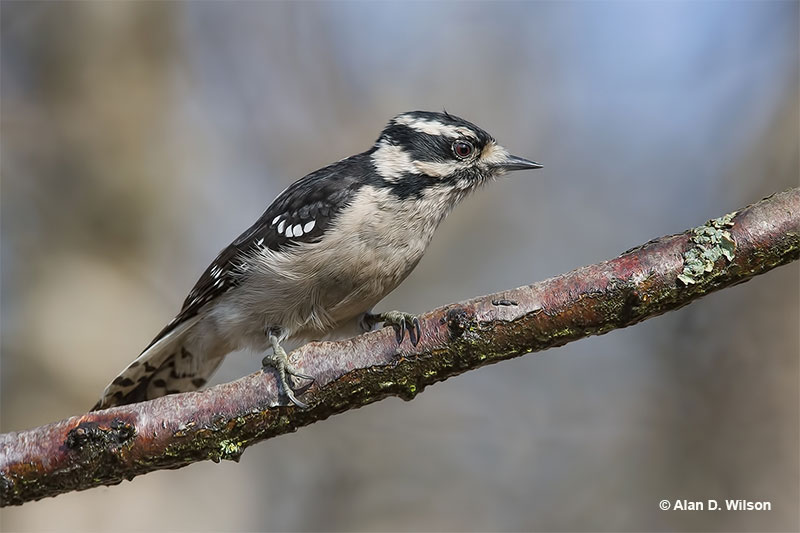
Scientific name: Dryobates pubescens
Length: 6.75 inches
Weight: .95 ounces
Wingspan: 12 inches
Song: “Pik! Ch,ch,ch,ch,ch,ch,ch!”
The Downy Woodpecker is a small black and white woodpecker with a short, black beak. They are patterned black and white above and have white backs and white underparts. Both sexes look alike except that males have a small, bright red patch on the top back part of their head.
Young birds look like adults but have a reddish patch on the top of their head. Downy Woodpeckers also have a few small black marks in their white outer tail feathers, and a small white tuft at the base of their beak.
This woodpecker eats insects, other small creatures, seeds, and small fruits. It pecks into live and dead wood and often forages on smaller branches and twigs. These friendly little woodpeckers are also common feeder birds.
They nest in tree cavities and live in gardens and a wide variety of woodlands. We see Downy Woodpeckers in much of Canada and the USA but not in arid habitats.
Key Identifications:
- Smallest woodpecker in North America. Mostly black and white with a short, black beak.
- Forages on trees, in bushes, and at feeders for insects, seeds, and suet.
- Nests in tree cavities.
- The Downy Woodpecker makes sharp “pik!” calls and also has a trilled call, “Ch,ch,ch,ch,ch,ch,ch!“.
Downy Woodpeckers are the smallest woodpecker species in North America and usually occur in pairs. They can also forage with other small birds and often visit feeders. This species takes advantage of its size to peck into the stems of weeds and other plants too small for larger woodpeckers to perch on.
7. Red-bellied Woodpecker
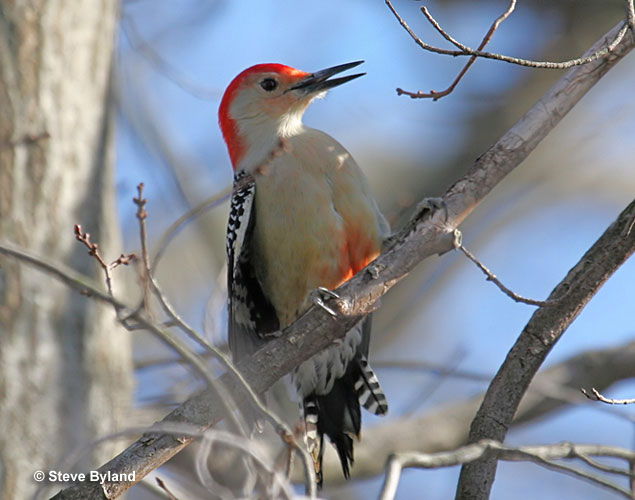
Scientific name: Melanerpes carolinus
Length: 9.25 inches
Weight: 2.2 ounces
Wingspan: 16 inches
Song: “Qwerr!”
Red-bellied Woodpeckers are medium-sized with black and white barring on their back and wings. They have a long beak and pale gray underparts with a small red patch on the belly.
Males have red on the head from the bill to the back of the neck (the nape). Females have an orange-red spot above their bill and red on the back of their head. Both sexes have a mostly white rump and central tail feathers.
This woodpecker species has long wings and “undulating” flight where it moves up and down as it flies. In flight, Red-bellied Woodpeckers show a small white patch in their wings.
The Red-bellied Woodpecker lives in wooded habitats. It eats nuts, seeds, insects, fruit, and can attack nestlings of other species. It also visits bird feeders.
This striking woodpecker occurs in pairs and nests in tree cavities high above the ground. It is common in the eastern USA and parts of southern Ontario.
Key Identifications:
- Grayish woodpecker with black and white barring above, and red on the top of the head and back of the neck.
- Forages for seeds, nuts, insects and other food on trunks and branches.
- Nests in a tree cavity, high overhead.
- Makes a loud exclamation, “Qwerr!“. It also makes other, briefer and quieter “chug” calls.
Red-bellied Woodpeckers are common and adaptable birds. As long as big trees are present, we see them in urban areas as well as wilder places. They also visit feeders and have a very long tongue. When extended, it sticks out 2 inches past the tip of its bill!
6. American Crow
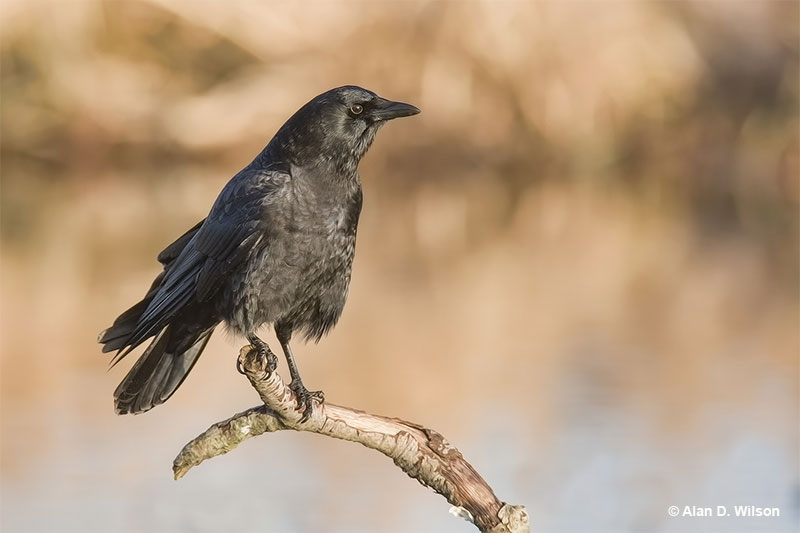
Scientific name: Corvus brachyrhynchos
Length: 17.5 inches
Weight: 1 pound
Wingspan: 39 inches
Song: “Caw! Caw!”
The American Crow is a big, all black bird with a strong, stout bill. In certain lighting, it can have metallic purple and blue iridescence.
Both sexes look the same and have some feathering on their beaks, long, broad wings, and a broad tail.
American Crows have direct flight with strong, steady wing beats. Crows are very social and intelligent birds that are usually seen in flocks. They forage together on the ground or in trees and eat just about anything they can find.
Some of their more regular foods include carrion, fruit, nuts, seeds, insects, and small animals. Like most jays and crow species, they also eat the eggs and nestlings of other bird species.
This species builds bulky stick nests high in trees and lives in most habitats except for high mountains and arid zones.
The American Crow occurs in southern Alaska and much of Canada and the USA.
Key Identifications:
- Big, all black bird with long, broad wing and a broad tail.
- Forages for carrion, fruit, seeds, insects, and small animals.
- Builds a bulky stick nest high in a tree.
- American Crows are very vocal birds. They can make several calls but their most common one is, “Caw! Caw! Caw!”.
The American Crow is a common, large black bird that frequently calls, “Caw! Caw! Caw!”. It usually occurs in flocks and lives in all sorts of places, even urban zones. These birds are very smart and have funerals or wakes! When a crow dies, other crows mark the occasion by gathering together and loudly calling.
5. Black-capped Chickadee
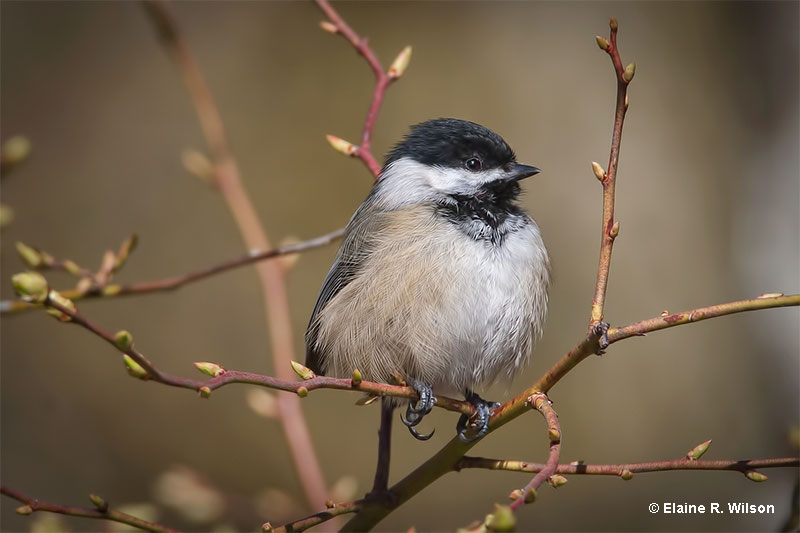
Scientific name: Poecile atricapilla
Length: 5.25 inches
Weight: .39 ounces
Wingspan: 8 inches
Song: “see bee, see bee”
Black-capped Chickadees are small grayish birds with a black cap, black throat, and a stubby black beak. Both sexes look alike and have a white face, white edging to the feathers in their wings, and some buff on their underparts.
These cute little birds feed on caterpillars, insects, spiders, seeds, and fruit. They are regular visitors to feeders but also forage on bark, twigs, and in foliage. When foraging, they often hang upside down from twigs and usually occur in small flocks.
This species makes a small, soft nest out of moss and deer hair. It builds its nest in tree cavities and can also use nest boxes.
Black-capped Chickadees live in a variety of wooded habitats and can also occur in gardens. They are year-round residents in parts of Alaska, Canada, and the northern USA south to Oregon, northern New Mexico, northern Ohio, and the Appalachian Mountains to North Carolina.
Key Identifications:
- Small, cute, grayish birds with a black cap, white face, and a black throat.
- Forages for insects, spiders, seeds, and fruit in wooded habitats. Also visits feeders.
- Nests in tree cavities and nest boxes.
- This little bird is quite vocal and often says its name, “chick-a-deedeedeedeedee“. They also make other chattering calls and sing a whistled song, “see bee, see bee“.
The Black-capped Chickadee is a small, acrobatic bird with a black cap, white face, and a black throat. It is also a state bird of Massachusetts. They usually forage in flocks with other chickadees and other small birds, and often visit feeders. This species hides dozens of seeds and other bits of food for the winter, and recalls where each of these food items are hidden.
4. Mourning Dove
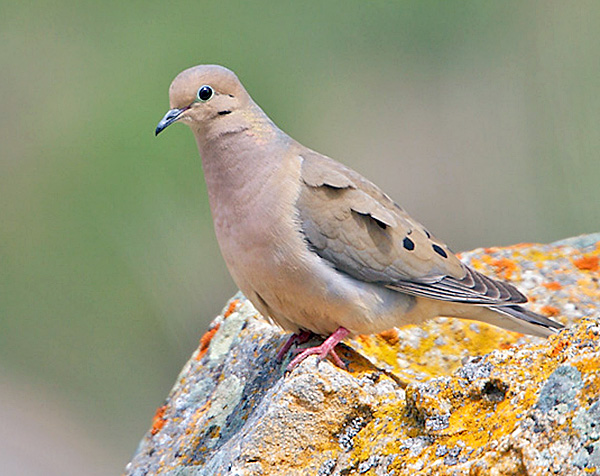
Photograph © Greg Lavaty.
Scientific name: Zenaida macroura
Length: 12 inches
Weight: 4.2 ounces
Wingspan: 18 inches
Song: “hooOOA, hoo, hoo, hoo”
Mourning Doves are medium-sized, grayish-brown doves with long tails. They have small black spots on their wings and a small head with a slender, dark beak.
Males and females also have narrow gray eyerings, a black mark on the face, and pale iridescent gold on the sides of their necks. They look alike except for males having more gray on the head and neck, and more iridescence.
This dove has fairly long wings and swift, direct flight. When flying, it shows black and white in its tail.
The Mourning Dove occurs in woodlands, gardens, on farms, and in urban areas. This common feeder visitor eats seeds and grains. It also forages in open situations, picking food from the ground.
This pleasant dove species can visit a feeder on its own or forage in small flocks. It builds an unkempt stick nest in bushes and trees and is very common throughout the USA, southern Canada, and Mexico.
Key Identifications:
- Plain brown and gray dove with a long, pointed tail.
- Feeds on seeds at feeders and on the ground in open areas.
- Makes a small, messy nest of sticks in trees.
- Sings a sad and owl-like “hooOOA, hoo, hoo, hoo”.
The Mourning Dove is the common garden dove in most of its range. It often visits feeders and its cooing song is commonly mistake for an owl. This species has a short lifespan with many adults only living for a couple of years or less.
3. American Robin

Photograph © Tom Grey
Scientific name: Turdus migratorius
Length: 10 inches
Weight: 2.7 ounces
Wingspan: 17 inches
Song: “cheery, cheery, cheery, cheery, cheer, cheer”
The American Robin is a familiar and common thrush that is dark gray above and brick red below. It also has an orange-yellow bill, a blackish head with white markings around the eyes and on the throat, and a white belly.
Both sexes of this thrush species are similar but males are darker above and more reddish on the underparts. Young American Robins have more white marks on their faces and spotting on orange underparts.
In flight, this common thrush in Kansas also shows white corners in its outer tail feathers.
American Robins forage on the ground for worms, insects, snails, and other small creatures. In winter, these common birds flock together and perch in trees and bushes to eat berries and fruit.
They reside in Alaska, most of Canada, the USA and in Mexico and are one of the most common backyard birds in Kansas.
Key Identifications:
- Fair-sized songbird that is dark gray above, and brick red and white below.
- Forages for worms and bugs on lawns and other open grassy areas, also flocks together to feed on fruiting trees in the winter.
- Makes a cup nest in trees.
- The American Robin is quite vocal and makes a loud, sharp, “yenk!” call and quieter “check,check,check” calls. It also has a lovely cheerful song of caroled phrases, “cheery, cheery, cheery, cheery, cheer, cheer”.
The American Robin is a common, handsome thrush with dark gray upperparts and brick red and white underparts. Populations of the American Robin have been estimated at 370,000,000; a number that gives this bird the distinction of being the most numerous landbird in North America.
2. Blue Jay
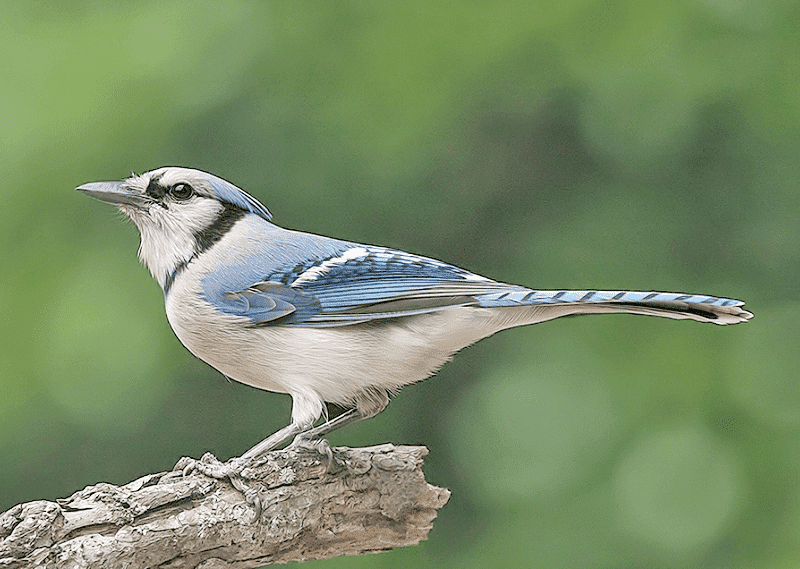
Photograph © Alan Wilson.
Scientific name: Cyanocitta cristata
Length: 11 inches
Weight: 3 ounces
Wingspan: 16 inches
Song: “Nyeah! Nyeah! Nyeah!”
The Blue Jay is a fairly large, crested bird with a straight black bill. Both sexes look alike and are blue above and gray and white below. They also have some small black lines on their faces, white cheeks, and a narrow black necklace that goes up to the side of their face and crest.
Blue Jays also have some white markings and black barring in their wings and on their tail. Young birds look like adults but are duller blue.
They make messy cup nests at various heights in a variety of trees.
These social and intelligent birds feed on acorns, nuts, insects, and other small creatures. Like other members of the jay and crow family, they eat the eggs and nestlings of other birds.
The Blue Jay is a common bird of woodlands, forest, and towns east of the Rocky Mountains in the USA and central and southern Canada.
Key Identifications:
- Crested, fairly large bird with bright blue above and gray below.
- Feeds in trees and at feeders. Eats acorns, nuts, insects and many other food items.
- Makes a messy cup nest of sticks in a tree.
- Very vocal. In flight, Blue Jays often call as they swoop through the trees. They make a variety of sounds and mimic some other birds. Common calls include a nasal and complaining “Nyeah! Nyeah! Nyeah!” and various whistled calls.
The Blue Jay is a common, intelligent, and noisy bird. They make their presence known with their loud calls and can visit feeders. Ironically, when communicating with each other at close quarters, this species makes much softer and quieter calls. It’s almost as if they are talking with each other!
1. Northern Cardinal (Most Popular Kansas Bird)
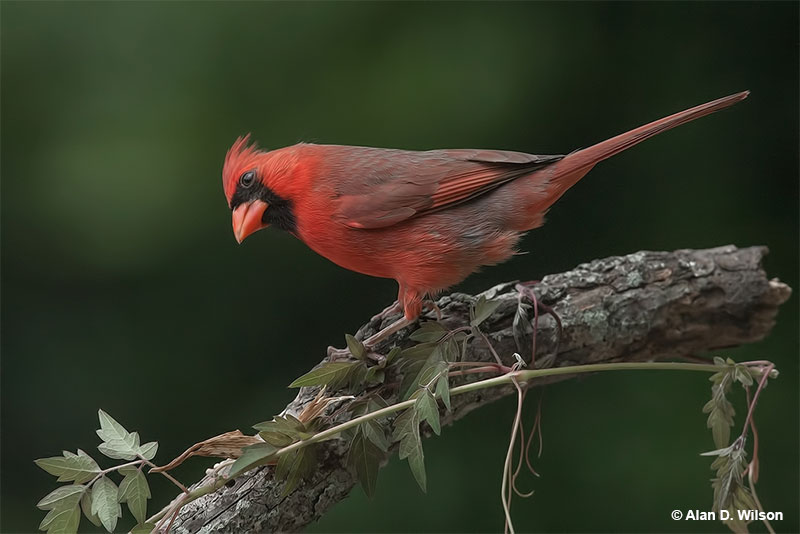
Scientific name: Cardinalis cardinalis
Length: 8.75 inches
Weight: 1.6 ounces
Wingspan: 12 inches
Song: “pichew-pichew-pichew, chew,chew,chew,chew,chew”
Northern Cardinals are medium-sized songbirds with a perky crest and big orange-red beak. Males are bright red with a black throat and face, and have dusky red on their back, wings, and tail.
Female Northern Cardinals are grayish-brown and buff with some black on their face and throat. They also have red highlights in their crest, wings, and long, rounded tail.
This species has short, rounded wings and seems to bounce up and down as they move through the air. In flight, Northern Cardinals also make sharp chip notes.
Northern Cardinals are common backyard birds of Kansas and regular visitors to bird feeders, where they love black-oil sunflower seeds. They forage on and near the ground but males sing from a prominent perch.
This beautiful bird occurs in pairs and nests in bushes and low trees. It is common in the eastern and southwestern USA, southern Ontario, and in Mexico.
Key Identifications:
- Crested bird with a conical orange-red beak and a black face. Males are red, females are grayish-brown and buff.
- Forages for seeds and insects on and near the ground.
- Makes a cup-shaped nest in bushes and low trees.
- Sings a clear, whistled song of repeated notes. They can sound like “cheer, cheer, chew, chew, chew, chew” or a quick “birdee,birdee,birdee,birdee,birdee“. They also make loud, sharp chip notes.
Northern Cardinals are one of the most beautiful common birds in most states, including Kansas. It’s no wonder seven different states chose it to be their official bird.
Frequently Asked Questions About Birds of Kansas
What is the most common bird in Kansas?
The most common bird in Kansas is the Northern Cardinal. There have been more sightings of this species on the eBird platform and in breeding bird surveys than any other bird species in Kansas.
What is the bird of Kansas?
The state bird of Kansas is the Western Meadowlark. This official state bird is common in many parts of Kansas.
What are the black and white birds in Kansas?
The black and white birds in Kansas are Lark Buntings (249th place according to eBird). In summer, male Lark Buntings are a common sight in western Kansas.
How many birds are in Kansas?
In total, 485 birds have been found in Kansas.
What is the big white bird in Kansas?
The big white bird in Kansas could be the Great Egret. This large, white wading bird is an elegant visitor to wetlands in the state. Another large white bird that lives in Kansas is the American White Pelican.
Does Kansas have Magpies?
Yes, Kansas has magpies. The Black-billed Magpie lives in the central and western part of the state.
What is the largest bird in Kansas?
The largest bird in Kansas is the American White Pelican. This bird species is 62 inches long, has a huge wingspan of nine feet, and weighs 16.4 pounds. The heaviest bird in Kansas is the 23 pound Trumpeter Swan, and the tallest bird that visits the state is the 4 to 5 foot tall Whooping Crane.
Does Kansas have Eagles?
Yes, Kansas has eagles. Two species of eagles occur in Kansas; the Bald Eagle and the Golden Eagle.
Does Kansas have owls?
Yes, Kansas has owls. Eleven species of owls have been seen in Kansas. Two of the most common ones are the Great Horned Owl and the Short-eared Owl.
What are the golden birds in Kansas?
The golden birds of Kansas could be the American Goldfinch and the Yellow Warbler. Both of these birds are bright yellow and common in much of the state.

